

Copy Editing vs. Proofreading: What’s the Difference?
Copy editing and proofreading both Unleash the Power of Precision on your work, ensuring that your words and sentences are tidy and broadcast the message you intend them to do. Both are crucial stages in the editorial process, but they involve different levels of scrutiny and focus on distinct aspects of a written work.
In this guide, we will explore the differences between copy editing and proofreading. We’ll also help you figure out which one you need and provide guidance on how to become a professional in either field. Get ready to learn how to polish your writing like a pro!
What is Copy Editing?
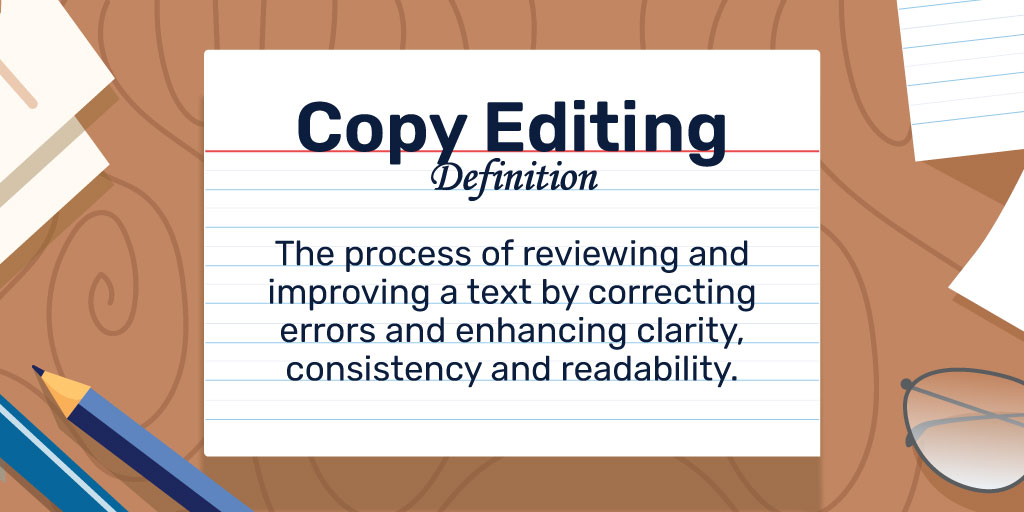
Copy editing is a careful and thorough process of reviewing and revising a written work to ensure its accuracy, clarity, coherence, consistency, and overall quality. It involves digging into the content at a deep level to enhance the readability and effectiveness of the text.
It typically takes place after the author has performed their own editing of the material. Copy editing goes far beyond grammar and spell-checking. It also focuses on improving elements like style, organization, and factual accuracy.
Scope of Work of Copy Editing

Let’s explore in more detail the extensive range of tasks involved in this editorial process, from refining grammar and style to verifying factual accuracy and enhancing overall readability.
- Style and consistency: Establish and maintain a consistent writing style and ensure that the document follows style guides uniformly throughout.
- Clarity and readability: Improve the overall clarity and coherence of the content by streamlining complicated sentences and enhancing the way ideas flow.
- Removing ambiguity: Identify and clarify any statements or phrases that are unclear or ambiguous in the text.
- Fact-checking: Verify the accuracy of the information in the document, including the dates, names, statistics, and other facts.
- Structure and organization: Examine the logical flow of the content, rearrange paragraphs if necessary, and strengthen transitions between sections.
- Language and tone: Adapt the wording and tone to the intended readership and goal of the document.
- Consistency in citations: Verify the accuracy and compliance with the chosen citation style of all references, footnotes, endnotes, and citations.
- Formatting and layout: Ensure consistent formatting, such as headings, subheadings, bullet points, numbering, and overall visual presentation.
- Grammar, spelling, and punctuation: Correct errors in grammar, ensuring accurate spelling, and proper usage of punctuation marks.
Examples of Copy Editing
As an example of the work copy editors do, look at the following paragraph from Dean Koontz’s Strangers n raw and copy-edited form:
Original Version:
“Dominick Corvaisis went to sleep under a light wool blanket and a crisp white sheet, sprawled alone in his bed, but he woke elsewhere-in the darkness at the back of the large foyer closet, behind concealing coats and jackets. He was curled in the fetal position. His hands were squeezed into tight fists. The muscles in his neck and arms ached from the tension of a bad though unremembered dream.”
Edited Version:
“Dominick Corvaisis fell asleep under a light wool blanket and a clean white sheet, comfortably sprawled in his bed. However, when he woke up, he found himself in a different place – in the darkness, tucked away at the back of a big closet in the foyer. He was curled up in a ball, with his hands clenched tightly into fists. His neck and arm muscles were sore from the tension caused by a disturbing dream that he couldn’t recall.”
Craft of Writing Quiz (Easy)

Your answer:
Correct answer:
SHARE YOUR RESULTS
Your Answers
What is Proofreading?
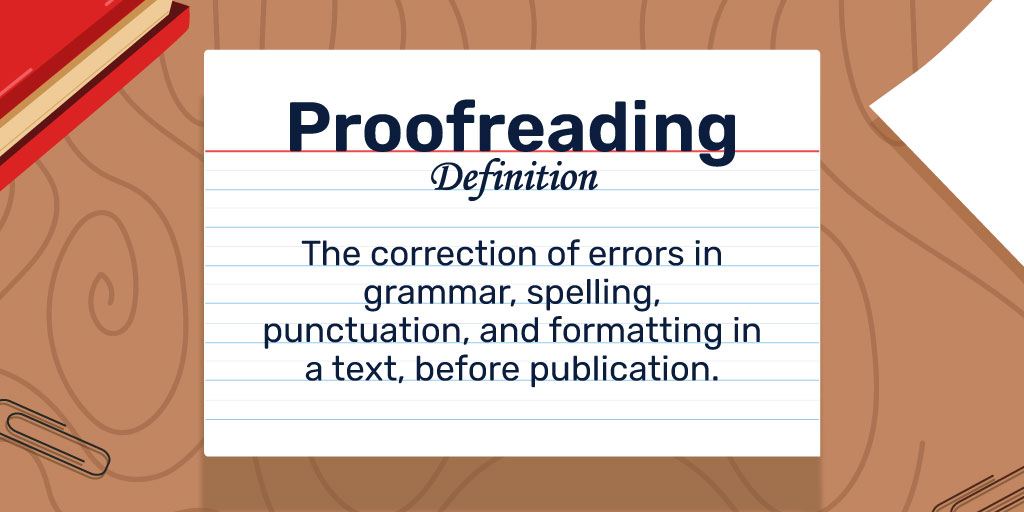
Proofreading is the last careful check before something gets published. It involves reading the material carefully to find and fix mistakes and inconsistencies that might have been missed during earlier edits. It’s all about making sure everything looks good and makes sense before it’s officially out there for everyone to see.
It is often based on a proof copy printed by the publisher before the final publication. During proofreading, the focus is primarily on the accuracy of grammar, spelling, punctuation, and formatting.
The aim is the final polish and refinement of a written work, rather than substantial changes to the content or structure. It aims to eliminate any remaining errors or inconsistencies that could detract from the professionalism and credibility of the document.
Scope of Work of Proofreading

Below, we will describe the range of tasks encompassed within the proofreading stage, from scrutinizing grammar and spelling to ensuring consistency and polishing the document’s visual presentation.
- Grammar: Check for errors in grammar, including subject-verb agreement, verb tenses, sentence structure, and usage of pronouns.
- Spelling: Verify the correct spelling of words and ensure that there are no misspelled words throughout the document.
- Punctuation: Review the proper usage of punctuation marks such as commas, periods, semicolons, colons, quotation marks, and apostrophes.
- Capitalization: Ensure consistent and appropriate capitalization of words, including proper nouns, titles, headings, and acronyms.
- Formatting: Check for consistency in formatting, such as font styles, font sizes, indentation, paragraph spacing, and alignment.
- Typographical errors: Identify and correct typographical errors, including transposed or missing letters, extra spaces, or incorrect characters.
- Consistency: Ensure consistency in language usage, terminology, abbreviations, acronyms, and formatting throughout the document.
- Cross-references: Verify the accuracy and consistency of cross-references, such as page numbers, figures, tables, and citations.
- Spacing and alignment: Check for proper spacing between words, sentences, and paragraphs, as well as align text and visual elements correctly.
Examples of Proofreading
As an example of the work proofreaders do, look at the following paragraph from Lisa Gardner’s The Perfect Husband in a raw and proofread form:
“ Now she remembered the feel of her finger tightening around the trigger. The pul of the trigger, the jerk of the trigger, the roar of the gun and the wringing in her ears. The acrid smell of gunpowder, and the hoarse sound of Jim’s cry. The thud of his body falling down. The raw sent of fresh blood pooling on her carpet.”
Proofread Version:
“Now she remembered the feel of her finger tightening around the trigger. The pull of the trigger, the jerk of the trigger, the roar of the gun, and the ringing in her ears. The acrid smell of gunpowder and the hoarse sound of Jim’s cry. The thud of his body falling down. The raw scent of fresh blood pooling on her carpet.”
Copy Editing vs. Proofreading
The main differences between Copy Editing and Proofreading lie in their depth of review, the scope of their changes, and their timing in the editing process. Regarding their depth of review, copy editing involves a comprehensive review of the content, including its clarity, organization, and factual accuracy. Proofreading, on the other hand, is a final, surface-level review that primarily focuses on identifying and correcting errors in grammar, spelling, punctuation, formatting, and typographical errors.
Copy editors may suggest substantial changes, such as rephrasing sentences, improving clarity and flow, restructuring paragraphs, and addressing inconsistencies. Proofreaders, on the contrary, primarily address surface-level errors and inconsistencies, making minor corrections to grammar, spelling, punctuation, and formatting.

Copy editing typically occurs before proofreading and serves as an intermediate stage in the editing process. It is conducted after the initial draft is complete, refining the content before the final proofreading stage. Proofreading, on the other hand, is the final stage of the editing process, taking place after copy editing. It ensures that the document is error-free and ready for publication.
Beyond these differences, both processes attend to grammar, spelling, punctuation, and formatting, and it is the objective of both to enhance the quality and professionalism of the written work. The following overview summarizes the key differences between copy editing and proofreading:
How to Become a Copy Editor or Proofreader?
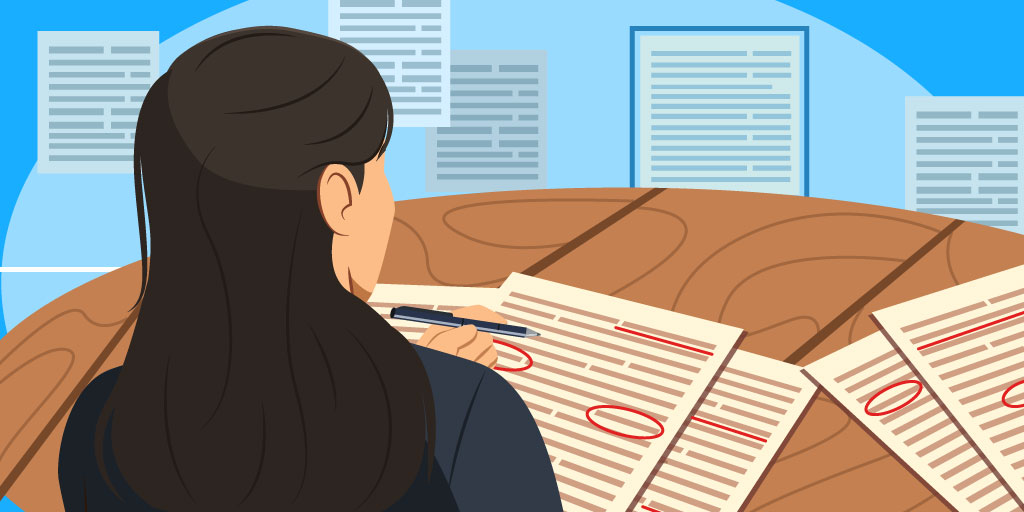
If you want to become a professional copy editor or proofreader, there are some fundamental steps that can lead you to both careers:
1. Develop Strong Language Skills
Enhance your knowledge of grammar, punctuation, spelling, and vocabulary. Read extensively to improve your understanding of language usage, styles of writing, and tone in different genres .
In both careers, you will be in a position to have to catch linguistic errors and inconsistencies, which you cannot do if you aren’t a serious language wiz.
You will also have to familiarize yourself with style guides, such as the Chicago Manual of Style , Associated Press Stylebook , or Oxford Style Manual , or at least have them on your bookshelf to use when you need them. Understanding and applying consistent style guidelines is crucial both in copy editing and proofreading.
2. Acquire Relevant Training
While not always mandatory, having a bachelor’s degree in English, journalism, communication, or a related field can provide a strong foundation. If you lack the time and/or money for a degree, consider pursuing courses in editing or proofreading to gain specialized knowledge.
Many universities or colleges offer short courses offline or online on platforms like Coursera or Udemy . UK Writers College offers a copy editing and proofreading course, where you can do it all in one, and The Publishing Training Centre runs a training program on the copy editing process, including on how to prepare documents for publication. Skillshare also offers many free courses at different quality levels, but make sure that it comes with a certificate so you can prove that you’ve completed it.
3. Develop Technical Skills
Familiarize yourself with word processing software such as Microsoft Word and Google Docs. Learn how to use tools like track changes, commenting features, spell- and grammar-checking, and formatting styles.
Many employers will require you to work in word processing software, because it is more efficient and accurate. They also allow for direct collaboration with the author. Track changes allows editors to suggest and implement revisions while maintaining a clear record of all modifications made to the document. Comments provide a convenient way to communicate with authors and discuss specific changes or queries.
The use of technology will also allow you to work remotely from any location and flexibly at any time, which makes it an essential tool to master.
4. Gain Practical Experience
Seek opportunities to gain hands-on experience in copy editing or proofreading.
Offer your services to websites, local organizations or charities to help with communication texts, local publications like small newspapers, or student organizations. Even if these jobs don’t pay, they will help you to build a portfolio of work.
The Society for Editors and Proofreaders is an organization that offers editorial services to organizations and publishers. They use volunteers to do the work and give training and credibility in exchange for your effort.
5. Assemble a Portfolio
Put together a professional portfolio of your work that showcases your copy editing or proofreading skills. If you are a proofreader, include samples of work that demonstrate your ability to identify and correct errors in grammar, spelling, punctuation, and formatting.
If you are a copy editor, put together samples that display a flare at cleaning up muddled sentences, correcting inaccurate information, and fixing up grammar and spelling.
A good portfolio requires that you include raw and edited copies of the work you have done to demonstrate your skills.
6. Network within the Industry
Attend industry events, join professional organizations or groups, and connect with other proofreaders or editors. Networking can provide valuable insights, job opportunities, and mentorship.
Consider signing up for a professional association for copy editors and proofreaders such as the Editorial Freelancers Association or the Society for Editing, both of which provide support, link editors and proofreaders with each other, and post jobs on their job boards for which their members can apply.
7. Apply for Your First Position
Once you’re done with your portfolio and you are ready to start working properly, start to search for freelance and entry-level editing and proofreading positions.
You can find paid freelance jobs on boards like Upwork and Indeed that may not pay much, but that will serve as valuable experience.
Send your resume and portfolio to publishing houses, editing agencies, content marketing firms, websites, public relations agencies, and any other organizations that produce written content.
The Society for Editing, American Society of Magazine Editors, Publishing Professionals Network, JournalismJobs.com, and Media Bistro are all good places to start.
Frequently Asked Questions
In this section, we aim to shed light on common queries surrounding the distinction between copy editing and proofreading, providing concise answers to help you grasp the nature of these two essential editorial processes.
What Are the Types of Copy Editing?
There are potentially many types, but the main forms are:
- Substantive or line editing: Check for coherence and flow of contents.
- Stylistic editing: Improve tone, voice, and readability.
- Mechanical editing: Repair grammar, spelling, punctuation, style guidelines, etc.
- Fact-checking editing: Check the accuracy of facts, names, and statistics.
- Academic editing: Verify adherence to academic conventions and referencing style.
What Are the Three Levels of Copy Editing?
The three levels of copy editing indicate varying degrees of thoroughness and intensity in the editing process. Each level focuses on different aspects and entails different tasks.
- Light copy editing: Correct grammar, spelling, punctuation, and formatting.
- Medium copy editing: Light copy editing, plus fix up unclear sentences and poor word choices.
- Heavy copy editing: Light and medium copy editing, plus restructure pages and paragraphs to improve clarity, logical flow, and coherence.
What Are the Cs of Copy Editing?
The “Cs of Copy Editing” is a mnemonic device used to highlight different areas of focus in the copy editing process. While the specific words associated with each “C” may vary, a common breakdown is clarity, consistency, correctness, completeness, conciseness, coherence, and consideration of the audience.
What Are the Common Problems in Copy Editing?
In copy editing, several common problems can arise that need to be addressed. They include grammar and syntax errors, spelling mistakes, inconsistent language usage, ambiguity, lack of clarity, poor structure, inaccurate information, inconsistency in formatting or style, weak transitions between paragraphs and sections, and lack of attention to the target audience.
What Are the Three Types of Proofreading?
The three types of proofreading can vary depending on the context and industry, but here are three commonly recognized types:
- Traditional proofreading: Correct errors in grammar, spelling, punctuation, and formatting.
- Comparative proofreading: Compare different versions of a document with each other for consistency.
- Electronic proofreading : Review an electronic text on the screen and make the changes directly in it.
What is the Main Purpose of Proofreading?
The main purpose of proofreading is to meticulously review written material, identifying and correcting errors in grammar, spelling, punctuation, formatting, and typographical mistakes. The ultimate goal is to ensure the document is accurate, polished, and free from any language or mechanical errors before it is published.
Is Proofreading a Form of Editing?
Yes, proofreading is considered a form of editing. While editing encompasses a broader range of tasks that also include refining and improving a written document, proofreading specifically focuses on polishing its grammar, spelling, punctuation, and formatting directly before it is published.
Why is It Called Proofreading?
The term “proofreading” originates from the traditional practice of reviewing the proof copies of printed materials before final publication. After the typesetting process, a “proof” is created to identify any errors, make necessary corrections, and ensure the accuracy and quality of the final printed product. The individuals responsible for this task are known as proofreaders.
Can the Same Person Do Copy Editing and Proofreading?
Yes, it is common for the same person to perform both copy editing and proofreading tasks, especially in smaller organizations or for smaller projects. Many copy editors possess the skills and knowledge to handle both editing stages effectively.
Final Thoughts
Understanding the difference between copy editing and proofreading is crucial for anyone involved in the writing and editing process. While both stages play essential roles in refining written material, copy editing focuses on content, clarity, and organization, while proofreading hones in on surface-level errors.
By recognizing and leveraging the unique strengths of each, writers and editors can ensure that their work is polished, accurate, and ready to make a lasting impact.
Craft of Writing Quiz (Hard)
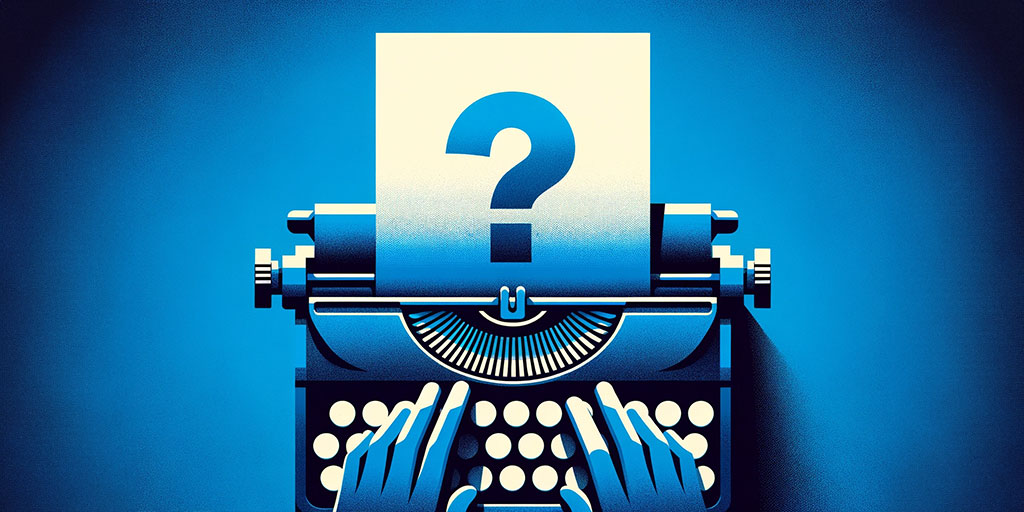
Yves Lummer
As the founder of BookBird, Yves Lummer has pioneered a thriving community for authors, leading more than 100,000 of them towards their dreams of self-publishing. His expertise in book marketing has become a catalyst for multiple best-sellers, establishing his reputation as an influential figure in the publishing world.

Elements of a Story: 8 Story Elements Explained
February 6, 2024

170 Book Puns: Funny Puns & Jokes You’ll Never Forget
February 4, 2024

Side Character: Definition, Examples & Writing Tips

How to Start a Story: 10 Secret Writing Tips

Inciting Incident: Definition, Purpose & Examples
January 23, 2024

Biography vs. Autobiography vs. Memoir: Art of Life Stories
November 22, 2023
Privacy Overview

Want to sell more Books?
Looking to publish? Meet your dream editor, designer and marketer on Reedsy.
Find the perfect editor for your next book
1 million authors trust the professionals on Reedsy. Come meet them.
Blog • Understanding Publishing
Posted on Jan 31, 2020
What is Proofreading? Beginner's Guide to an Essential Edit
Whether you’re a student, a mechanic, a doctor, or a professional writer, you’ve probably come across proofreading in some form or another — though you might not be aware of it. So much of the work people do these days revolves around the written word. Mistakes in their writing can have a massive impact on their success — which is where proofreading comes in!
In this post, we’ll have a look at the ins and outs of proofreading, from the perspective of experienced proofreaders in the publishing trade .
What is proofreading?
Proofreading is the act of reading written work and marking any errors. These mistakes most commonly involve spelling, grammar, punctuation, and consistency .
What is a proof?
The ‘proof’ in ‘ proofreader ’ comes from the publishing term describing an early printed copy. Traditionally, typesetters would arrange letters tiles onto large plates that are then used to print pages of a book. But before they started churning out thousands of copies, a ‘proof’ version was sent to the publisher for a final check.
With modern digital publishing (and computerized printing methods), proofreading is now usually done on a computer — though some proofreaders still prefer marking up physical copies .
What is the difference between proofreading and editing?
In publishing, proofreading comes into play at the very end of the editorial process , after a manuscript has been corrected by a copy or line editor . The proofreader’s job is to comb through the document and look for any mistakes that may have slipped through the cracks. Regardless of how meticulous the writer and editor have been, there will almost always be errors when you’re dealing with a book of 80,000 words or more.

If you'd like to confirm which type of editing your book needs at its current stage, we recommend taking this quick quiz to find out:
What kind of editing does your book need?
Takes one minute!
Why is proofreading important?
You might remember, in early 2019, the television hit series Game of Thrones was coming to an end. Devoted and casual fans alike sat in front of screens to devour every moment of the final season. So it’s no surprise that when a Starbucks cup made an accidental cameo during one of the episodes, viewers were pointing out the gaff on social media in a heartbeat.
The show’s producers were quick to act, and 48 hours later the disposable cup had been edited out of the show. Yet there’s no denying that hundreds, if not thousands, of viewers were yanked from the medieval realm of Westeros because of this tiny appearance of a modern artefact. Suddenly, the focus is on the error, and not the story.
Do you see where we’re going with this? A manuscript peppered with typos, grammatical errors, or contextual inconsistencies will jolt a reader out of the narrative the book is meant to tell. Instead of getting caught up in the story or thesis, they’re suddenly forced to mentally rectify the work’s mechanical mistakes. So proofreading is partly important because it allows your narrative to shine through uninterrupted.
What’s more, it adds a level of professionalism that is absolutely necessary if you’re looking to get publishers or readers on your side. When confronted with an obviously un-proofed book, both audiences will likely assume the author couldn’t be bothered to truly invest in their work. And if the author didn’t seem bothered to invest, why should they?
So whether you’re planning to seek out traditional representation for your book or to publish on your own, editing and proofreading is a vital part of the publishing process.
Working with a professional proofreader
A professional proofreader does more than just look out for spelling, grammar, and punctuation mistakes. They will also look for consistency issues that could hamper the reading experience. This would include:
- Ensuring that any web links go to the right webpage
- Checking that the index matches the content
- Confirming that the layout doesn’t fluctuate throughout the work
- Making sure that the images have correct captions
- Verifying that the copy adheres to the author’s chosen style guide
Proofreaders will not usually copy-edit, meaning that they won't make changes directly to the manuscript. Their primary job is highlighting potential mistakes, allowing the writer or editor to make the final decision.
Who should use professional proofreading?
In traditional publishing, every book will be proofed before it’s released to the public. If a reader were to find more than a handful of typos or grammatical mistakes in a novel, for example, it could negatively color their reading experience (and damage the publisher’s reputation).
In self-publishing, proofreading is becoming a non-negotiable part of the editorial process. Independent authors often look for ways to reduce their costs, so they’re often tempted to proofread by themselves. But as the indie book market grows and its products improve in quality, getting a professional proofread is fast becoming common practice.
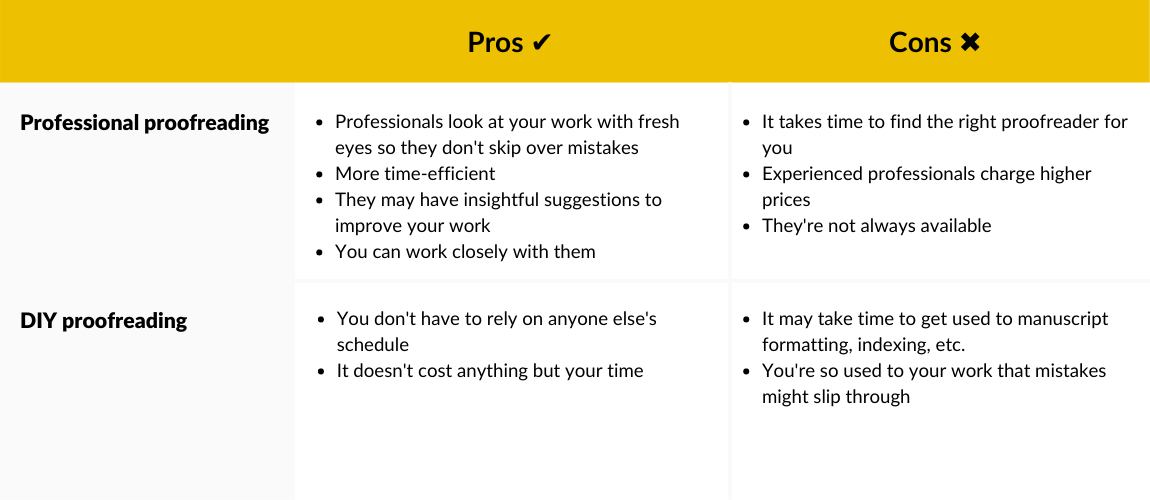
Outside of trade publishing, proofreaders will often find work in areas such as academia, journalism, and even advertising . In some corporate settings, they can even be hired to check through slide decks before presentations.
How much does a professional proofreader cost?
Based on statistics from Reedsy’s marketplace , proofreading services cost $10 per thousand words, on average.
Of course, this is only a ballpark figure and the final rate will depend on a number of other factors. For example, if the proofreader needs to cross-check the index, this would naturally escalate the cost.
In non-publishing industries, costs may also vary. A proofreader with a deep background in technical writing may choose to charge extra for their expertise and fact-checking, for example. But whatever the cost, you can be sure that getting a professional proofreader is worth it.
Tips for finding a professional proofreader
There are a lot of proofreaders advertising their services out there — where do you begin to find the right one for your project? We’ve got some pointers down below.
- Ask your editor. If you’re already working with an editor, it’s worth asking if they offer proofreading services. If not, they probably know other professionals that they trust will be good for your project.
- Specify your preferences. Do you like to work digitally or do you focus better reading a printed manuscript? The proofreading process is a two-way street, and when both you and the professional agree on a method, everything will be much smoother and more efficient.
- Search niche marketplaces. If you’re writing a book, it’s better to go straight to editing societies' directories or publishing marketplaces, where the proofreaders’ credentials are checked, than to browse Upwork or Fiverr. That way you don't have to spend hours sifting through portfolios of proofreaders who aren't equipped with the right knowledge to advise you, not just on your writing but also on formatting your manuscript.

Polish your book with a professional
Meet Neil Gaiman's, George R. R. Martin's, and George W. Bush's editors and proofreaders at Reedsy
Learn how Reedsy can help you craft a beautiful book.
Proofreading your own work

When it comes to a longer piece of writing meant for wider consumption — like, say, a book — there’s still nothing that can beat a trained professional.
For other types of content, however, writers can and do proofread their own work. Simply reading back something you’ve written will usually reveal typos and ungainly passages. In situations where your writing isn’t intended for a massive audience (for example, in an email to your boss), you can usually rely on an online spelling and grammar checker such as Grammarly to catch any major mistakes.
Let’s cover a couple of DIY proofreading tips to help you ensure your work is as polished as can be.
Proofreading tips
- Start with self-awareness . There are certain bad grammatical habits we’re all prone to, or particular typos that tend to crop up frequently in our work. Before you get started, take a moment to determine your own "bad writing habits." Then do a sweep of your work, concentrating just on those. For example, perhaps there's a word you know you overuse? Search for just that word and really consider whether it needs to be there.
- Read out loud. The truth is, your eyes can deceive you — and this is especially true if you're reading on a screen, where your eyes are quick to tire. You'd be surprised at how many mistakes you can spot reading something out loud vs. reading it silently in your head. A bonus tip here is to read your manuscript out loud with someone else. Take turns reading a set number of pages each, and you'll ensure you catch any awkward-sounding phrases.
- Do one thing at a time. The worst way to proofread your own work is to read through it and try to get it perfect by the end. Effective proofreading requires multiple rounds, and each round should be focused on just one task. Don't look for spelling errors at the same time as you check for homonyms, as you'll likely end up letting stuff fall through the cracks.
[updated: 08/26/2020 UTC]
Looking for a proofreader? Sign up for a free Reedsy account and browse through the best freelancers in the business.
Andrew Knight New Canaan says:
16/05/2019 – 06:34
Awesome Post. I really like it. This is a very informative post. Thanks for sharing with us. I would like to share with my friends.
Comments are currently closed.
Continue reading
Recommended posts from the Reedsy Blog

The 6 Best Ghostwriting Companies to Write Your Book
Learn which companies you can trust if you want to find a ghostwriter to write your next book.

How to Publish a Book For Free: The 7 Best Sites
If you want to publish your book without spending a single dime, check out this handy list of 7 free self-publishing services.

5 Ways to Save on Your Self-Publishing Budget
If you want to self-publish a book without breaking the bank, here are 5 tips to ensure you still get the best result possible.

30 Great Book Dedication Examples to Inspire Your Own
A list of 30 of the best book dedications in the business, that'll have you crying, laughing, and crying laughing.

Expository Writing: The Craft of Sharing Information
Expository writing is a fundamental part of how we learn and make sense of the world. Learn all about it in this post.

Additional Reviews: Query Critique December 2024
Additional critiques from Reedsy's December 2024 query letter session.
Join a community of over 1 million authors
Reedsy is more than just a blog. Become a member today to discover how we can help you publish a beautiful book.
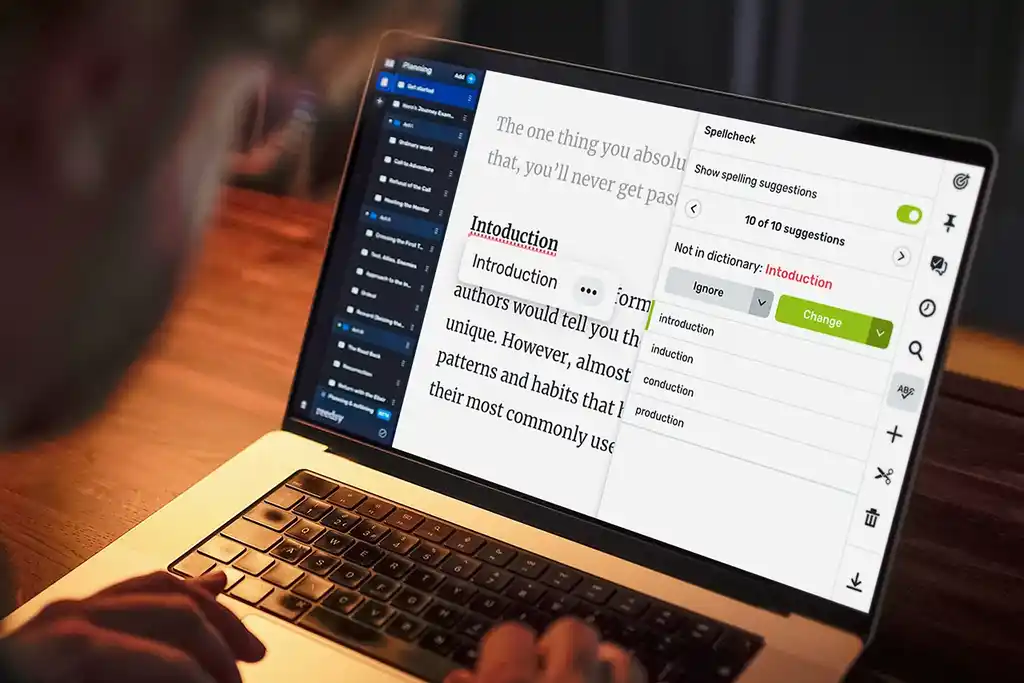
Catch your errors
Polish your writing in the *free* Reedsy Book Editor.

1 million authors trust the professionals on Reedsy. Come meet them.
Enter your email or get started with a social account:

Editing and Proofreading
What this handout is about.
This handout provides some tips and strategies for revising your writing. To give you a chance to practice proofreading, we have left seven errors (three spelling errors, two punctuation errors, and two grammatical errors) in the text of this handout. See if you can spot them!
Is editing the same thing as proofreading?
Not exactly. Although many people use the terms interchangeably, editing and proofreading are two different stages of the revision process. Both demand close and careful reading, but they focus on different aspects of the writing and employ different techniques.
Some tips that apply to both editing and proofreading
- Get some distance from the text! It’s hard to edit or proofread a paper that you’ve just finished writing—it’s still to familiar, and you tend to skip over a lot of errors. Put the paper aside for a few hours, days, or weeks. Go for a run. Take a trip to the beach. Clear your head of what you’ve written so you can take a fresh look at the paper and see what is really on the page. Better yet, give the paper to a friend—you can’t get much more distance than that. Someone who is reading the paper for the first time, comes to it with completely fresh eyes.
- Decide which medium lets you proofread most carefully. Some people like to work right at the computer, while others like to sit back with a printed copy that they can mark up as they read.
- Try changing the look of your document. Altering the size, spacing, color, or style of the text may trick your brain into thinking it’s seeing an unfamiliar document, and that can help you get a different perspective on what you’ve written.
- Find a quiet place to work. Don’t try to do your proofreading in front of the TV or while you’re chugging away on the treadmill. Find a place where you can concentrate and avoid distractions.
- If possible, do your editing and proofreading in several short blocks of time. Your concentration may start to wane if you try to proofread the entire text at one time.
- If you’re short on time, you may wish to prioritize. Make sure that you complete the most important editing and proofreading tasks.
Editing is what you begin doing as soon as you finish your first draft. You reread your draft to see, for example, whether the paper is well-organized, the transitions between paragraphs are smooth, and your evidence really backs up your argument. You can edit on several levels:
Have you done everything the assignment requires? Are the claims you make accurate? If it is required to do so, does your paper make an argument? Is the argument complete? Are all of your claims consistent? Have you supported each point with adequate evidence? Is all of the information in your paper relevant to the assignment and/or your overall writing goal? (For additional tips, see our handouts on understanding assignments and developing an argument .)
Overall structure
Does your paper have an appropriate introduction and conclusion? Is your thesis clearly stated in your introduction? Is it clear how each paragraph in the body of your paper is related to your thesis? Are the paragraphs arranged in a logical sequence? Have you made clear transitions between paragraphs? One way to check the structure of your paper is to make a reverse outline of the paper after you have written the first draft. (See our handouts on introductions , conclusions , thesis statements , and transitions .)
Structure within paragraphs
Does each paragraph have a clear topic sentence? Does each paragraph stick to one main idea? Are there any extraneous or missing sentences in any of your paragraphs? (See our handout on paragraph development .)
Have you defined any important terms that might be unclear to your reader? Is the meaning of each sentence clear? (One way to answer this question is to read your paper one sentence at a time, starting at the end and working backwards so that you will not unconsciously fill in content from previous sentences.) Is it clear what each pronoun (he, she, it, they, which, who, this, etc.) refers to? Have you chosen the proper words to express your ideas? Avoid using words you find in the thesaurus that aren’t part of your normal vocabulary; you may misuse them.
Have you used an appropriate tone (formal, informal, persuasive, etc.)? Is your use of gendered language (masculine and feminine pronouns like “he” or “she,” words like “fireman” that contain “man,” and words that some people incorrectly assume apply to only one gender—for example, some people assume “nurse” must refer to a woman) appropriate? Have you varied the length and structure of your sentences? Do you tends to use the passive voice too often? Does your writing contain a lot of unnecessary phrases like “there is,” “there are,” “due to the fact that,” etc.? Do you repeat a strong word (for example, a vivid main verb) unnecessarily? (For tips, see our handouts on style and gender-inclusive language .)
Have you appropriately cited quotes, paraphrases, and ideas you got from sources? Are your citations in the correct format? (See the UNC Libraries citation tutorial for more information.)
As you edit at all of these levels, you will usually make significant revisions to the content and wording of your paper. Keep an eye out for patterns of error; knowing what kinds of problems you tend to have will be helpful, especially if you are editing a large document like a thesis or dissertation. Once you have identified a pattern, you can develop techniques for spotting and correcting future instances of that pattern. For example, if you notice that you often discuss several distinct topics in each paragraph, you can go through your paper and underline the key words in each paragraph, then break the paragraphs up so that each one focuses on just one main idea.
Proofreading
Proofreading is the final stage of the editing process, focusing on surface errors such as misspellings and mistakes in grammar and punctuation. You should proofread only after you have finished all of your other editing revisions.
Why proofread? It’s the content that really matters, right?
Content is important. But like it or not, the way a paper looks affects the way others judge it. When you’ve worked hard to develop and present your ideas, you don’t want careless errors distracting your reader from what you have to say. It’s worth paying attention to the details that help you to make a good impression.
Most people devote only a few minutes to proofreading, hoping to catch any glaring errors that jump out from the page. But a quick and cursory reading, especially after you’ve been working long and hard on a paper, usually misses a lot. It’s better to work with a definite plan that helps you to search systematically for specific kinds of errors.
Sure, this takes a little extra time, but it pays off in the end. If you know that you have an effective way to catch errors when the paper is almost finished, you can worry less about editing while you are writing your first drafts. This makes the entire writing proccess more efficient.
Try to keep the editing and proofreading processes separate. When you are editing an early draft, you don’t want to be bothered with thinking about punctuation, grammar, and spelling. If your worrying about the spelling of a word or the placement of a comma, you’re not focusing on the more important task of developing and connecting ideas.
The proofreading process
You probably already use some of the strategies discussed below. Experiment with different tactics until you find a system that works well for you. The important thing is to make the process systematic and focused so that you catch as many errors as possible in the least amount of time.
- Don’t rely entirely on spelling checkers. These can be useful tools but they are far from foolproof. Spell checkers have a limited dictionary, so some words that show up as misspelled may really just not be in their memory. In addition, spell checkers will not catch misspellings that form another valid word. For example, if you type “your” instead of “you’re,” “to” instead of “too,” or “there” instead of “their,” the spell checker won’t catch the error.
- Grammar checkers can be even more problematic. These programs work with a limited number of rules, so they can’t identify every error and often make mistakes. They also fail to give thorough explanations to help you understand why a sentence should be revised. You may want to use a grammar checker to help you identify potential run-on sentences or too-frequent use of the passive voice, but you need to be able to evaluate the feedback it provides.
- Proofread for only one kind of error at a time. If you try to identify and revise too many things at once, you risk losing focus, and your proofreading will be less effective. It’s easier to catch grammar errors if you aren’t checking punctuation and spelling at the same time. In addition, some of the techniques that work well for spotting one kind of mistake won’t catch others.
- Read slow, and read every word. Try reading out loud , which forces you to say each word and also lets you hear how the words sound together. When you read silently or too quickly, you may skip over errors or make unconscious corrections.
- Separate the text into individual sentences. This is another technique to help you to read every sentence carefully. Simply press the return key after every period so that every line begins a new sentence. Then read each sentence separately, looking for grammar, punctuation, or spelling errors. If you’re working with a printed copy, try using an opaque object like a ruler or a piece of paper to isolate the line you’re working on.
- Circle every punctuation mark. This forces you to look at each one. As you circle, ask yourself if the punctuation is correct.
- Read the paper backwards. This technique is helpful for checking spelling. Start with the last word on the last page and work your way back to the beginning, reading each word separately. Because content, punctuation, and grammar won’t make any sense, your focus will be entirely on the spelling of each word. You can also read backwards sentence by sentence to check grammar; this will help you avoid becoming distracted by content issues.
- Proofreading is a learning process. You’re not just looking for errors that you recognize; you’re also learning to recognize and correct new errors. This is where handbooks and dictionaries come in. Keep the ones you find helpful close at hand as you proofread.
- Ignorance may be bliss, but it won’t make you a better proofreader. You’ll often find things that don’t seem quite right to you, but you may not be quite sure what’s wrong either. A word looks like it might be misspelled, but the spell checker didn’t catch it. You think you need a comma between two words, but you’re not sure why. Should you use “that” instead of “which”? If you’re not sure about something, look it up.
- The proofreading process becomes more efficient as you develop and practice a systematic strategy. You’ll learn to identify the specific areas of your own writing that need careful attention, and knowing that you have a sound method for finding errors will help you to focus more on developing your ideas while you are drafting the paper.
Think you’ve got it?
Then give it a try, if you haven’t already! This handout contains seven errors our proofreader should have caught: three spelling errors, two punctuation errors, and two grammatical errors. Try to find them, and then check a version of this page with the errors marked in red to see if you’re a proofreading star.
Works consulted
We consulted these works while writing this handout. This is not a comprehensive list of resources on the handout’s topic, and we encourage you to do your own research to find additional publications. Please do not use this list as a model for the format of your own reference list, as it may not match the citation style you are using. For guidance on formatting citations, please see the UNC Libraries citation tutorial . We revise these tips periodically and welcome feedback.
Especially for non-native speakers of English:
Ascher, Allen. 2006. Think About Editing: An ESL Guide for the Harbrace Handbooks . Boston: Wadsworth Cengage Learning.
Lane, Janet, and Ellen Lange. 2012. Writing Clearly: Grammar for Editing , 3rd ed. Boston: Heinle.
For everyone:
Einsohn, Amy. 2011. The Copyeditor’s Handbook: A Guide for Book Publishing and Corporate Communications , 3rd ed. Berkeley: University of California Press.
Lanham, Richard A. 2006. Revising Prose , 5th ed. New York: Pearson Longman.
Tarshis, Barry. 1998. How to Be Your Own Best Editor: The Toolkit for Everyone Who Writes . New York: Three Rivers Press.
You may reproduce it for non-commercial use if you use the entire handout and attribute the source: The Writing Center, University of North Carolina at Chapel Hill
Make a Gift

Copy Editing Vs Proofreading: What's The Difference?
Copy editing enhances clarity, consistency, and correctness, addressing grammar, style, and factual accuracy.
Proofreading is the final check, focusing on catching typos, spelling errors, and formatting issues, ensuring the text is polished for publication.
Copy editing and proofreading are essential processes in the world of writing. Both play a crucial role in ensuring that a written work is free of errors and is of high quality. However, many people often confuse the two or use them interchangeably. In this article, we will delve into the differences between copy editing and proofreading and the benefits of each process.
Copy editing involves reviewing and correcting the text for grammar, spelling, punctuation, consistency, and style. It is a comprehensive process that involves revising the text for clarity and readability, ensuring that it is well-structured, and making suggestions for improvement. On the other hand, proofreading is the final step in the editing process and involves checking the text for any remaining errors such as typos, misspellings, and grammatical mistakes.
In this article, we will provide a step-by-step guide to understanding the differences and benefits of copy editing and proofreading. We will also discuss the various options available for editing and proofreading, including hiring a professional and DIY techniques. Whether you are a writer, student, or professional, this article will provide you with a comprehensive understanding of the importance of copy editing and proofreading in the world of writing.
Table of Contents
What is Copy Editing?
What is proofreading, key differences between copy editing and proofreading, common misconceptions about copy editing and proofreading, role of technology in modern copy editing and proofreading, copy editing and proofreading in different genres, benefits of copy editing and proofreading, industry standards for copy editing and proofreading, the future of copy editing and proofreading in publishing, hiring a professional copy editor or proofreader, diy copy editing and proofreading, copy editing and proofreading tips for writers, ethical considerations in copy editing and proofreading.
- Books to Read
Copy editing is an integral part of the writing process that involves reviewing and correcting the text for grammar, spelling, punctuation, consistency, and style. The goal of copy editing is to improve the overall quality of the text and make it clear, concise, and easy to understand.
The copy editing process involves several tasks, including:
- Checking the text for grammar, spelling, and punctuation errors
- Ensuring consistency in style, tone, and language use
- Checking the text's overall structure and making suggestions for improvement
- Ensuring the text is clear and easy to understand
- Making suggestions for rewording awkward or unclear sentences
Copy editing is typically the first step in the editing process, and it is done before proofreading. The objective of copy editing is to correct any errors in the text and improve its overall quality and readability. A well-edited text is more likely to engage the reader, convey the intended message effectively, and leave a lasting impression.
Copy editing is a comprehensive process that requires a keen eye for detail, a good understanding of grammar and style, and a thorough knowledge of the English language. It is a time-consuming process that requires a lot of patience and attention to detail, but the end result is a well-written and error-free text.
Proofreading is the final step in the editing process and involves checking the text for any remaining errors such as typos, misspellings, and grammatical mistakes. The goal of proofreading is to catch any errors that may have been missed during the copy editing process and ensure that the text is error-free and ready for publication or distribution.
The proofreading process involves several tasks, including:
- Checking the text for typos and misspellings
- Checking the text for grammatical errors
- Checking the text for consistency in spelling, punctuation, and style
- Ensuring that all numbers and dates are accurate
- Checking the text's overall appearance, including page numbers, headings, and margins
Proofreading is typically the last step in the editing process and is done after copy editing. It is a critical step in ensuring that the text is error-free and ready for publication or distribution. A well-proofread text is more likely to be well-received by the reader and convey the intended message effectively.
Proofreading requires a keen eye for detail and a good understanding of grammar and style. It is a time-consuming process, but it is essential for ensuring that the text is error-free and ready for its intended purpose.
Copy editing and proofreading are two distinct processes in the world of writing, and it is important to understand the differences between the two. The following are some key differences between copy editing and proofreading:
- Scope of work: Copy editing is a comprehensive process that involves reviewing and correcting the text for grammar, spelling, punctuation, consistency, and style. Proofreading, on the other hand, is a more focused process that involves checking the text for any remaining errors after copy editing has been completed.
- Timing: Copy editing is typically done before proofreading, while proofreading is the final step in the editing process.
- Tasks involved: Copy editing involves checking grammar, spelling, punctuation, consistency, and style, and making suggestions for improvement. Proofreading involves checking for typos, misspellings, grammatical mistakes, and ensuring consistency in spelling, punctuation, and style.
- Level of detail: Copy editing involves a more in-depth review of the text, while proofreading is a more focused and superficial review of the text.
It is important to understand the differences between copy editing and proofreading so that you can choose the right editing process for your writing needs. While both processes are important, the appropriate process will depend on the stage of your writing and the specific needs of your text.
For example, if your text is in need of a comprehensive review and improvement, then copy editing is the appropriate choice. If your text has already been edited and you just need a final check for errors, then proofreading is the appropriate choice.
In conclusion, both copy editing and proofreading play important roles in the writing process, and it is important to understand the differences between the two so that you can choose the right process for your writing needs.
Copy editing and proofreading are essential stages in the process of publishing, yet they are often misunderstood. This section aims to debunk some of the most common misconceptions surrounding these critical tasks.
Misconception 1: Copy Editing and Proofreading Are the Same
One prevalent misconception is that copy editing and proofreading are interchangeable. While they both aim to polish written content, their focus areas differ significantly. Copy editing involves a deep dive into the text to improve style, clarity, consistency, and correctness. In contrast, proofreading is the final step, focusing on surface errors like typos, grammar, and formatting inconsistencies.
Misconception 2: Automated Tools Can Replace Human Editors
With the advent of advanced grammar and spell-check tools, there's a belief that these can replace human editors. While these tools are helpful, they lack the nuanced understanding of context, tone, and style that a professional editor brings to the table.
Misconception 3: Proofreading Is Just About Fixing Typos
Many assume proofreading is solely about correcting spelling mistakes. However, it encompasses more, including checking for consistency in layout, font usage, and adherence to formatting guidelines.
Misconception 4: Copy Editing Is Only for Removing Errors
Another common myth is that copy editing is just about error removal. In reality, copy editors also focus on enhancing the overall readability and flow of the text, ensuring that it communicates its message effectively.
Misconception 5: Every Writer Can Self-Edit and Proofread Effectively
While self-editing is an important skill, it's often challenging for writers to catch their own mistakes. A fresh pair of eyes, especially those of a professional editor, can spot errors and inconsistencies that the writer might overlook.
Technology has revolutionized the fields of copy editing and proofreading, offering tools and solutions that enhance efficiency and accuracy. This section explores how technology is shaping these practices in the modern era.
Advanced Software and Tools
Modern copy editors and proofreaders utilize a variety of software and tools designed to streamline their work. From sophisticated grammar checkers to style guides available at the click of a button, these resources help professionals maintain high standards of accuracy and consistency in their editing tasks.
Artificial Intelligence and Machine Learning
The integration of AI and machine learning has brought a new dimension to editing and proofreading. These technologies offer predictive text analysis, context-aware grammar suggestions, and even style recommendations, thereby augmenting the human editor’s capabilities.
Collaboration Platforms
Technology has also fostered better collaboration between writers, editors, and proofreaders. Platforms like Google Docs and project management tools enable real-time communication and feedback, making the editing process more dynamic and interactive.
Enhanced Accessibility and Reach
Digital tools have made editing and proofreading services more accessible. Editors and proofreaders can now work with clients from any part of the world, breaking geographical barriers and expanding their reach.
The Balance Between Technology and Human Expertise
While technology plays a crucial role, the importance of human expertise remains paramount. Editors and proofreaders bring a level of nuanced understanding and creativity to the text that technology alone cannot replicate. Thus, the most effective approach combines technological tools with the skilled judgment of a professional.
Copy editing and proofreading practices vary significantly across different genres. Each genre has its unique style, tone, and set of conventions that editors and proofreaders must adapt to. This section delves into how these tasks differ in various genres.
In fiction, copy editors and proofreaders focus on maintaining the author's voice while ensuring narrative coherence and stylistic consistency. They pay close attention to character development, plot structure, and dialogue, alongside the standard grammatical and spelling checks.
Academic Writing
Academic writing demands a high level of precision. Copy editors and proofreaders in this genre ensure that the text adheres to specific citation styles and academic conventions, while also clarifying complex arguments and checking for factual accuracy.
Technical Writing
Technical writing requires clarity and precision. Editors and proofreaders ensure that technical jargon is used appropriately and that instructions or explanations are clear and unambiguous. Consistency in terminology is crucial in this genre.
Business and Marketing
In business and marketing materials, the focus is on clarity, persuasiveness, and brand consistency. Copy editors and proofreaders ensure that the content aligns with the brand's voice and messaging, and is tailored to its target audience.
For journalism, fact-checking is as important as language editing. Editors and proofreaders work to ensure the accuracy of information while maintaining journalistic integrity and adhering to ethical standards of reporting.
Web Content and Blogs
Web content and blogs require a balance between engaging, conversational language and SEO optimization. Editors and proofreaders in this genre focus on readability, keyword integration, and ensuring content is up-to-date and relevant.
The Role of Genre-Specific Knowledge
Effective copy editing and proofreading in any genre require not just language expertise but also a deep understanding of genre-specific conventions. Editors and proofreaders must continuously update their knowledge to cater to the evolving demands of different genres.
Copy editing and proofreading are essential processes in the world of writing, and they offer several benefits to writers, students, and professionals. The following are some of the key benefits of copy editing and proofreading:
- Improved writing quality: Copy editing and proofreading help to improve the overall quality of a written work. By catching errors and making suggestions for improvement, copy editing and proofreading can help to make a text clear, concise, and easy to understand.
- Increased credibility: A well-edited and proofread text is more likely to be credible and well-received by the reader. An error-free text conveys professionalism and attention to detail, which can increase the credibility of the writer and the text.
- Enhanced readability: Copy editing and proofreading help to make a text more readable by catching errors and making suggestions for improvement. A well-edited and proofread text is more likely to engage the reader and hold their attention.
- Avoidance of errors: Copy editing and proofreading help to catch errors in a written work, which can save the writer from embarrassment and potential legal issues. By catching errors, copy editing and proofreading can help to ensure that a text is error-free and ready for publication or distribution.
In conclusion, copy editing and proofreading are important processes in the world of writing, and they offer several benefits to writers, students, and professionals. By improving writing quality, increasing credibility, enhancing readability, and avoiding errors, copy editing and proofreading can help to make a text the best it can be.
In the world of publishing, maintaining high-quality standards in copy editing and proofreading is crucial. This section explores the established industry standards that guide these processes.
Style Guides and Manuals
One of the cornerstones of industry standards are the style guides and manuals. Publications often adhere to specific style guides like APA, MLA, or Chicago Manual of Style, which provide detailed guidelines on language, formatting, and citation practices.
Accuracy and Consistency
Accuracy in grammar, punctuation, and spelling is a fundamental standard in copy editing and proofreading. Equally important is consistency in style, tone, and formatting throughout the document.
Ethical Editing Practices
Industry standards emphasize ethical editing practices. This includes respecting the author's voice and intent, ensuring transparency in editing changes, and maintaining the confidentiality of the manuscript.
Adherence to Publishing Protocols
Each publishing entity, be it a journal, a book publisher, or a news outlet, has its own set of protocols and standards. Editors and proofreaders must be familiar with these and ensure adherence to specific publishing requirements.
Continual Learning and Adaptation
The publishing world is ever-evolving, and so are its standards. Professionals in the field are expected to engage in continual learning and adaptation to stay abreast of the latest trends and changes in editing and proofreading practices.
Quality Assurance Processes
Quality assurance processes are integral to maintaining industry standards. These include multiple rounds of editing and proofreading, often by different professionals, to ensure the highest level of accuracy and quality.
As the publishing industry evolves, so too does the landscape of copy editing and proofreading. This section examines potential trends and developments shaping the future of these essential practices.
Technological Advancements
The continued advancement of technology, especially AI and machine learning, is set to further transform copy editing and proofreading. Future tools may offer even more sophisticated assistance in language correction, style optimization, and even content suggestion.
Increased Focus on Digital Content
With the shift towards digital media, copy editing and proofreading will likely see a greater focus on online content. This includes adapting to various digital formats and understanding the nuances of web-based writing, such as SEO and multimedia integration.
Globalization and Localization
The globalization of content creation necessitates expertise in localization – adapting content for different languages and cultures. This trend will likely demand more from editors and proofreaders in terms of cultural sensitivity and multilingual capabilities.
Collaborative and Remote Work Environments
Remote work and collaborative online environments are becoming the norm. This shift influences how editorial teams operate, emphasizing the need for effective communication tools and practices in a digital workspace.
Expanding Roles and Skills
Copy editors and proofreaders may find their roles expanding to include broader content management responsibilities, requiring additional skills in areas like content strategy, digital marketing, and data analysis.
Emphasis on Continuous Learning
As the industry evolves, there will be a growing emphasis on continuous learning and professional development for copy editors and proofreaders to stay relevant and effective in their roles.
One option for copy editing and proofreading is to hire a professional. Professional copy editors and proofreaders are trained experts who have the knowledge, skills, and experience to improve the quality of a written work. Here are some of the key benefits of hiring a professional copy editor or proofreader:
- Expertise: Professional copy editors and proofreaders are trained experts who have the knowledge, skills, and experience to improve the quality of a written work. They have a thorough understanding of grammar, style, and the English language, and they are able to catch errors and make suggestions for improvement that may have been missed by the writer.
- Objectivity: Professional copy editors and proofreaders are objective and impartial, which means that they are able to provide an unbiased review of the text. They are not emotionally attached to the text, which allows them to provide a more thorough and objective review.
- Saved time: Hiring a professional copy editor or proofreader can save the writer time and effort. The writer can focus on writing, while the professional takes care of the editing and proofreading process. This can help to speed up the overall writing process and reduce the writer's workload.
- Improved quality: Hiring a professional copy editor or proofreader can help to improve the quality of the text. A well-edited and proofread text is more likely to be of high quality and free of errors, which can enhance its credibility and readability.
When hiring a professional copy editor or proofreader, it is important to choose someone who has the relevant experience and expertise for your specific writing needs. There are several online platforms, such as Upwork and Freelancer , where you can find and hire professional copy editors and proofreaders. You can also check the credentials of potential candidates and read reviews from past clients to ensure that you choose the right professional for your needs.
In conclusion, hiring a professional copy editor or proofreader is a great option for writers, students, and professionals who want to improve the quality of their writing. With the expertise, objectivity, saved time, and improved quality that a professional can offer, hiring a professional is a smart choice for anyone looking to take their writing to the next level.
Another option for copy editing and proofreading is to do it yourself. While hiring a professional copy editor or proofreader is a great option, there are also several benefits to doing the copy editing and proofreading yourself. Here are some of the key benefits of DIY copy editing and proofreading:
- Cost-effective: DIY copy editing and proofreading is a cost-effective option as it does not require paying for professional services. This can be a great option for those who are working with a limited budget or who want to save money.
- Flexibility: DIY copy editing and proofreading allows for greater flexibility in terms of timing and process. You can work on your text at your own pace and in a way that suits your needs.
- Greater control: DIY copy editing and proofreading gives you greater control over the editing and proofreading process. You have the final say over what changes are made to your text, which can be particularly important for writers who are sensitive about their writing style and tone.
- Learning opportunity: DIY copy editing and proofreading can be a great learning opportunity. By reviewing and correcting your own text, you can improve your writing skills, learn more about grammar and style, and become a better writer.
If you decide to do the copy editing and proofreading yourself, there are several resources that can help you. For example, you can use online grammar and spelling checkers, such as Grammarly or ProWritingAid , to help with the editing and proofreading process. You can also find guides and tutorials on copy editing and proofreading, such as the Purdue Online Writing Lab , to help you improve your skills and knowledge.
In conclusion, DIY copy editing and proofreading is a great option for those who want to save money, have greater control over the editing process, or want to improve their writing skills. With the right resources and a little effort, anyone can become a successful DIY copy editor and proofreader.
Effective copy editing and proofreading can significantly elevate the quality of a writer's work. This section offers practical tips and strategies for writers looking to refine their editing and proofreading skills.
Understand the Difference
First and foremost, understand the distinct roles of copy editing and proofreading. Copy editing involves refining the text for clarity, coherence, and consistency, while proofreading is about catching surface errors. Recognizing this difference helps in approaching each task with the right mindset.
Take a Break Before Editing
After finishing a draft, take a break before beginning the editing process. This allows you to return to your work with fresh eyes, making it easier to spot errors and inconsistencies.
Reading your text aloud is a powerful way to catch awkward phrasings, repetitive words, and even missed punctuation. It also helps in assessing the flow and rhythm of your writing.
Use Editing Tools Wisely
While editing tools and software can be incredibly helpful, rely on them judiciously. Use them to flag potential issues, but always make the final judgment based on your understanding of the context and content.

Focus on One Type of Error at a Time
When proofreading, tackle one type of error at a time - first spelling, then grammar, then punctuation, and so on. This focused approach increases your chances of catching more errors.
Seek External Feedback
Getting feedback from others, be it peers or a professional editor, can provide invaluable insights. They can spot issues you may have overlooked and offer suggestions to enhance your writing.
Keep a Checklist
Maintain a checklist of common mistakes you make in your writing. Refer to this list during the editing and proofreading process to ensure you address these recurrent issues.
Understand Your Audience
Tailor your editing and proofreading according to your audience. What works for a technical paper may not suit a creative narrative. Understanding your audience's expectations helps in making appropriate edits.
Practice Makes Perfect
Lastly, remember that effective editing and proofreading skills are developed over time. Regular practice and exposure to different types of texts will enhance your proficiency in these tasks.
Copy editing and proofreading are not just about correcting texts but also involve adhering to ethical standards. This section explores the ethical considerations that professionals in these fields must navigate.
Respecting the Author's Voice
An essential ethical principle in editing and proofreading is to respect and preserve the author's voice and intent. Editors and proofreaders should make corrections and suggestions without altering the original tone or style, unless it significantly enhances clarity or readability.
Transparency in Changes
Editors and proofreaders should maintain transparency with authors about the changes made. This involves using track changes or providing summaries of significant edits, ensuring authors are fully aware of modifications in their work.
Avoiding Plagiarism
Ensuring that the text does not inadvertently plagiarize other works is a key ethical responsibility. This includes checking for proper citations and paraphrasing, as well as advising authors on the importance of crediting original sources.
Confidentiality
Maintaining the confidentiality of the author's work is paramount. Editors and proofreaders must not disclose any content or details of the work without the author's permission.
Cultural Sensitivity and Bias
It's crucial to approach texts with cultural sensitivity and an awareness of potential bias. Editors and proofreaders should strive to recognize and address any content that could be culturally insensitive or inadvertently biased.
Accuracy and Fact-Checking
While it's primarily the author's responsibility, editors and proofreaders should also be vigilant about the accuracy of facts in the text, especially in non-fiction and journalistic works, to uphold the integrity of the content.
Boundaries of Editing
Understanding the boundaries of their role is important for editors and proofreaders. They should avoid making changes that drastically alter the content's meaning or making unwarranted content suggestions that may lead to ethical dilemmas.
What is the difference between copy editing and proofreading?
Copy editing and proofreading are two distinct processes in the world of writing. Copy editing involves reviewing and correcting the text for grammar, spelling, punctuation, consistency, and style, while proofreading involves checking the text for any remaining errors after copy editing has been completed. Copy editing is typically done before proofreading and is a more comprehensive process, while proofreading is the final step in the editing process and is a more focused process.
What are the benefits of copy editing and proofreading?
Copy editing and proofreading offer several benefits, including improved writing quality, increased credibility, enhanced readability, and avoidance of errors. These processes help to make a text clear, concise, and easy to understand, and they increase the credibility of the writer and the text. They also help to catch errors and ensure that the text is error-free and ready for publication or distribution.
What is the difference between hiring a professional copy editor or proofreader and doing it yourself?
Hiring a professional copy editor or proofreader offers benefits such as expertise, objectivity, saved time, and improved quality, while doing it yourself offers benefits such as cost-effectiveness, flexibility, greater control, and a learning opportunity. The appropriate choice will depend on the writer's budget, preferences, and writing needs. Hiring a professional is a great option for those who want to improve the quality of their writing and have the budget to do so, while doing it yourself is a great option for those who want to save money and improve their writing skills.
What is the difference between copyediting and proofreading?
Copyediting involves refining the content for clarity, style, and coherence, focusing on grammar, spelling, and punctuation. It also includes ensuring consistency in language and adherence to editorial guidelines. Proofreading, on the other hand, is the final stage of editing that involves checking for minor mistakes such as typos, formatting issues, and missed errors. It’s a quality assurance step taken after copyediting to ensure the document is error-free.
Are copy editors proofreaders?
While copy editors and proofreaders share some skills, they are distinct roles. Copy editors focus on refining the text for style, clarity, and consistency, addressing more substantive changes. Proofreaders, however, focus on correcting surface errors such as typos, punctuation, and formatting inconsistencies, usually after the copyediting stage. Some professionals offer both services, but each role requires a different focus and skill set.
What are the 5 C's of copyediting?
The 5 C's of copyediting are Clarity, Coherence, Consistency, Correctness, and Creativity. Clarity ensures the text is understandable; Coherence checks the logical flow; Consistency maintains uniformity in style and tone; Correctness involves accuracy in grammar, punctuation, and facts; Creativity, though less discussed, involves enhancing the text while respecting the author's voice and style.
What is the difference between revision editing and proofreading?
Revision editing, often part of copyediting, involves substantial changes to a text, focusing on improving clarity, flow, structure, and overall readability. It may include reorganizing sections, rewriting paragraphs, and enhancing language use. Proofreading, in contrast, is the final stage of editing, focusing on surface errors like spelling, grammar, and punctuation, ensuring the document is polished and ready for publication.
Book to Read
For those who want to learn more about copy editing and proofreading, here are three non-fiction books that readers of this article would find interesting:
- The Chicago Manual of Style by University of Chicago Press Staff - This comprehensive guide to style and usage is a must-have for writers, editors, and proofreaders. It covers everything from grammar and punctuation to style and usage, and it is widely considered to be the authority on style in the publishing industry.
- Eats, Shoots & Leaves: The Zero Tolerance Approach to Punctuation by Lynne Truss - This entertaining and informative book explores the importance of punctuation and the role it plays in written communication. It covers the basics of punctuation and offers helpful tips and tricks for improving your writing skills.
- On Writing Well: An Informal Guide to Writing Nonfiction by William Zinsser - This classic guide to writing offers practical advice on how to write clear, concise, and effective nonfiction. It covers everything from the writing process to editing and revision, and it is a must-read for anyone who wants to improve their writing skills.
Copy editing and proofreading are essential processes in the world of writing. They help to improve the quality, credibility, and readability of a text and ensure that it is free of errors. Whether you decide to hire a professional copy editor or proofreader, or do it yourself, the key is to take the time to review and correct your text. With the right resources and a little effort, anyone can become a successful copy editor and proofreader.
This article has provided an overview of copy editing and proofreading, including their definitions, key differences, benefits, and the pros and cons of hiring a professional or doing it yourself. We've also included a list of further reading for those who want to learn more about these important processes in the world of writing.
In conclusion, copy editing and proofreading are important steps in the writing process that should not be overlooked. Whether you are a writer, student, or professional, taking the time to edit and proofread your work will help to ensure that it is of high quality and ready for publication or distribution. So, don't be afraid to take your writing to the next level, and start editing and proofreading today!
Further Reading
- What Are The 5 Cs Of Copyediting?
- What Is The Difference Between Copy Editing, Revising And Proofreading?
- How Much Does Copyediting Cost?
Claim your free eBook today and join over 25,000 writers who have read and benefited from this ebook.
'It is probably one of the best books on writing I've read so far.' Miz Bent


The Differences Between Line Editing, Copy Editing, and Proofreading

Today’s guest post is an excerpt from the new book Cover to Cover: What First-Time Authors Need to Know about Editing by Sandra Wendel .
Editors disagree about many of the finer points of their work such as whether to capitalize the word president (no, generally, but yes with President Lincoln ), whether to spell out numbers (some styles say yes to every number lower than 10 or lower than 100), or whether to use the serial comma that preceded this clause ( Chicago Manual of Style says yes). Some purists would argue that this post’s headline should read among instead of between . But I digress.
Editors also disagree about whether to start a sentence with And . And of course editors disagree about what constitutes the levels of editing that are often labeled copy editing, line editing, and proofreading—or just simply editing.
For guidance, I turned to the authority, the Chicago manual. Yet even that widely accepted all-knowing guide doesn’t make a distinction among editing levels: “Manuscript editing, also called copy editing or line editing, requires attention to every word and mark of punctuation in a manuscript, a thorough knowledge of the style to be followed, and the ability to make quick, logical, and defensible decisions.”
New authors are often confused about what level of editing they need, and rightly so. I hope to offer insight into the differences between line editing, copy editing, and proofreading.
[ Note from Jane: If you’d like to learn about development editing and content editing, which should come before copy editing, line editing, or proofreading, please see this comprehensive post on finding an editor .]
What to Expect with a Line Edit
In a line edit, an editor examines every word and every sentence and every paragraph and every section and every chapter and the entirety of your written manuscript. Typos, wrong words, misspellings, double words, punctuation, run-on sentences, long paragraphs, subheadings, chapter titles, table of contents, author bios—everything is scrutinized, corrected, tracked, and commented on.
Facts are checked, name spellings of people and places are confirmed. This is the type of edit I perform most often.
Your editor will likely do the following:
- Conduct heavier fact checking (for example, exact titles of movies in italics, death date of a famous person in history, the protagonist was using an iPhone before they were invented).
- Make suggestions about moving or removing text (or actually doing the task and explaining in a marginal note why).
- Initiate a discussion about why the dreary Introduction could be cut.
- Offer a new scheme for moving a chapter or two around to better accommodate a time line. (Actually doing the moving and writing transitions might fall into the category of developmental edit or left to the author to do.)
- Query the author in a marginal note about why Susan in chapter 2 was wearing a winter coat when the scene takes place in summer. Or whether the author intended for the detective described earlier with a full beard to be scratching his stubble.
- Point out repetition and inconsistencies in the story line. But not rewriting. Actually revise awkward sentences, break up long sentences, streamline sentences with clauses and parentheticals. Recast sentences that begin with There are and It is . Those constructions are simply not strong. That’s why line editing is considered a sentence-level type of edit.
- Substitute stronger words for the commonly overused words ( very, pretty, things, great, and good are my pet peeves).
Let me show you what an edit can do. This is a paragraph from Chris Meyer’s book Life in 20 Lessons . Chris is a funeral home director. A line edit would turn this rough paragraph—
The more regular are the things that make life so cruel and unfair: a healthy man has a heart attack on his bike ride, a child stricken with cancer, a mother dying before her children reach middle school, a father on vacation with his children, a son abalone fishing because it brings him joy, a daughter in an auto wreck with her best girlfriends, a simple slip and fall, gunshots, the list is as endless as it is tragic.
—into this:
More likely are the events surrounding death that make life so cruel and unfair: a healthy man has a heart attack on his bike ride; a child is stricken with leukemia; a mother dies before her children reach middle school; a father suffers a fatal stroke while on vacation with his children; a son drowns while abalone fishing; a daughter is killed instantly in an auto wreck with her best girlfriends; a simple slip and fall, gunshots, the list is as endless as it is tragic.
What to Expect from a Copy Edit
When an author says, “I just want a copy edit,” I ask what they mean. Again, there is confusion about what a copy edit includes. Most of the time, authors want that thorough line edit. If a manuscript is so clean, so squeaky clean, so perfectly written with lovely paragraphing and fine-tuned punctuation, then maybe the manuscript just needs a copy edit. Like never. I can’t even recall a manuscript that has come to me this clean that it would need just one pass for a polish for mechanical issues. Never. Not even books written by professional writers. And not even my own book. I hired out my line editing, and it’s a humbling process.
So let’s just agree that when someone says copy edit, they really mean a much deeper and more thorough edit than putting commas in the right place. A copy edit is the lowest level of edit. Rarely does a manuscript need “just” a copy edit. Sometimes a copy edit is a final step performed separately by your editor or someone else with fresh eyes. Some editors (like me) do copy editing all along looking for these types of errors, and a copy edit is part of the line edit.
Here’s my simple checklist:
- Correct any typos, which would include misspelled words.
- Fill in missing words.
- Format the manuscript before production, and that includes just one space between sentences (I don’t care what you learned in typing class in high school, the double space messes up the document when it is converted into real book pages).
- Streamline punctuation and properly use commas, periods, and em dashes—like this.
- Avoid overuse of ellipses to denote a break in thought … when they are really used to show missing text. And those exclamation marks! I allow authors about five in each manuscript. Overuse them, and they lose their punch.
- Make sure the names of characters and places are spelled consistently throughout (Peterson in chapter 1 may or may not be the same Petersen in chapter 6).
- Find and replace similarly sounding words that have different meanings (for example, effect and affect ).
- Conduct a modest fact check (perform a Google search to find the exact spelling of Katharine Hepburn or the capital of Mongolia). This isn’t Jeopardy! , so you do get to consult resources. I keep a window open to Google just for such searches.
- Make new paragraphs to break up long passages.
- Question the use of song lyrics and remind the author to get written permission.
- Point out, in academic work, that footnote 6 does not have a reference source in the citations.
- Remove overuse of quotation marks. For emphasis, use italics , but sparingly. Books generally do not use boldface .
- Impose a consistent style for the text (this means using a style guide for capitalization and hyphenation, treatment of numbers, heading levels). The Chicago Manual of Style is preferred unless the work needs to conform to an academic convention such as APA, AMA, or MLA.
What to Expect from a Proofread
Let’s say your manuscript is fully edited (no matter which level you chose, sometimes even a developmental followed by a line edit with the same or different editors). Your work will need a proofread either in manuscript format or after it is designed in pages as PDFs.
Should you proofread your own work? The short answer is later, if you’re in writing mode. The shorter answer is never. Why? Because it’s your work. And your brain plays funny tricks on you. It will fill in your words, and you’ll be completely shocked when a professional editor returns your edited manuscript. What? How could I miss that?
Most editors won’t admit this, but we, too, miss things. We’re human (or many of us are). So the question on the table is when to proofread.
I prefer to hire proofreaders to proof for absolute error when the manuscript is in final pages or PDFs. But you can also proofread before it goes into production (and into PDFs), just knowing that you do need another proofing of the PDFs.
Use a different person, a different editor, even someone who is a professional proofreader. This person brings a fresh set of eyes to the work and scours for absolute error such as name misspellings, wrong URLs, bad URLs, numbers that don’t add up in a table, double words, missing words, and those crazy stupid errors you as the author have missed and your editor missed, and you question your sanity. Those errors.
A proofreader doing the proofing at the PDF stage will look for all these types of errors plus others: bad word breaks and hyphenation at the end of a line, hyphen stacks (many words hyphenated at the ends of lines, stacked), widows and orphans (single words or lines at the top or bottom of a page), wrong captions with photos, page numbering, missing and misspelled headers and footers, page numbering matches with the table of contents, lines too tight or too loose. Many of these production issues are introduced as pages are created.
Proofreading is not the time to revise, rewrite, and delete. Your interior page designer might actually kill you. At the very least, major changes in proofing in PDFs can be time intensive and expensive. Put in the work way before you see your baby in actual page layouts.
Parting Advice
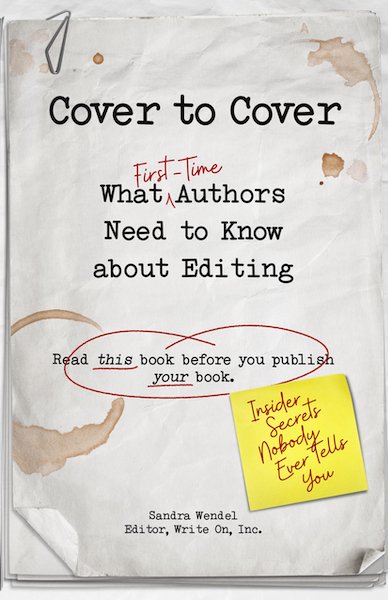
As Random House copy chief Benjamin Dreyer said in his exceptionally fascinating book, Dreyer’s English , “My job is to lay my hands on that piece of writing and make it … better. Cleaner. Clearer. More efficient. Not to rewrite it … but to burnish and polish it and make it the best possible version of itself that it can be.”
In editing world, even if editors disagree on what constitutes certain types of editing, we do agree that your manuscript deserves a professional and sound edit to make it free of typical errors of spelling and punctuation, with proper use of the right word, judicial paragraphing, logical chapter breaks and chapter titles, and prudent fact checking for accuracy—and, above all, consistency.
Note from Jane: if you enjoyed this post, be sure to check out Sandra’s new book Cover to Cover: What First-Time Authors Need to Know about Editing .

Sandra Wendel, a nonfiction editor of award-winning business/leadership, memoir, true crime, and self-help books, is the author of the new book, Cover to Cover: What First-Time Authors Need to Know about Editing , and the moderator of the Facebook page: FirstTimeAuthorsClub. Find out more at her website .
This site uses Akismet to reduce spam. Learn how your comment data is processed .
Great post. New authors might also need to understand substantive editing—the process of looking at an entire manuscript and commenting on structure, narrative arc, pacing, character development, etc. Line editing, copy editing, and proof-reading come after the substantive edit, which is usually where the editing process starts. Does the book begin and end in the right place? (Astonishing how often the first and last chapters can be cut. I once had the unpleasant but highly effective task of telling an author her book started on page 93.) Are all the scenes in the right order? Is that bit of background really necessary or could it be dispensed with in a well-placed scrap of dialogue? Are characters well introduced and do they develop through the story? Is the tone consistent throughout? Is the pacing compelling throughout? Often, the substantive edit results in no marks on the manuscript but rather, a long editor’s note that points out weaknesses and strengths and possible solutions. Excellent line editors and copy editors abound, but skilled substantive editors are thin on the ground, and a godsend to writers, whether new to the writing world or veterans.
[…] on the definitions Jane Friedman uses in her article ( https://janefriedman.com/the-differences-between-line-editing-copy-editing-and-proofreading/ ), my editing involves a blend of line and copy editing, with some Word formatting magic thrown in, […]
There’s never any end to an edit. I say it like that because I just finished a most curiously funny novel called “Never any End to Paris,” which turns out to be much about writing. By the Spanish writer, Enrique Vila-Matas. But back to editing … I’m currently conducting my wife’s brilliant novel through the editing process, and successfully convincing her that it’s money well spent to send the ms through all these levels of edit. With a self-pub book, it’s not about the money, but about giving birth to the best off-spring possible. Almost done. Proofreading next. There’s never any end to worrying about that hidden typo.
[…] is necessary for our work to reach that professional level. Sandra Wendel reveals the differences between line editing, copy editing, and proofreading; Patti Callahan Henry describes self-editing by ear, and Terry Odell urges playing tricks with […]
Fantastic article and genuinely clarified some elements for me. Thank you!
I really wish authors would understand the critical importance of hiring someone else to do the editing. If you want to improve yourself, and your writing, this is what you need to do.
[…] The differences between line editing, copy editing, and proofreading from Jane Friedman […]
I’ve read four different articles explaining the difference between line edits and copy edits, and I’m still confused. One article conflated the two within the same article (maybe the writer needed another edit or two), and the rest all seem to contradict one another.

Proofreading vs. Editing: Understanding the Key Differences
When it comes to writing, whether it’s a novel, a blog post, or an academic paper, both editing and proofreading play important roles in refining each piece of writing. However, people often confuse these processes or consider them a single task, which can cause confusion about their respective roles in improving written work.
Proofreading is similar to polishing a gemstone. It identifies surface-level errors like typos, grammatical mistakes, punctuation inconsistencies, and formatting irregularities that may have gone unnoticed in earlier revisions. It serves as the final check to ensure your text is error-free and ready for your audience.
On the other hand, editing is a more detailed process that involves thoroughly examining and restructuring sentence structure, eliminating ambiguity in language, ensuring logical coherence, maintaining the flow of the narrative, and refining the voice to align with the intended message. To achieve exceptional writing, editing requires an intricate understanding of language mechanics and storytelling nuances. In this blog post, we will discuss proofreading vs. editing in detail and how they can improve your writing.
What is Editing and Proofreading?
Editing and proofreading play crucial roles in producing professional-quality written work. While editors edit the content for clarity and engagement, proofreaders add that final touch of finesse by catching those sneaky errors that may escape even the most careful writer’s eye. By recognizing the unique contributions of each process— editing vs proofreadin g writers can ensure their work shines brilliantly before it reaches its intended audience. Let’s dive into the details.
What is Editing?
Editing involves a systematic review and modification of a written piece to enhance its clarity, coherence, and overall quality. It encompasses a range of tasks to refine the text’s content, structure, style, and tone to align it more closely with the author’s intentions and the audience’s expectations.
Objectives of Editing
The primary objectives of editing revolve around improving various aspects of the text to make it more engaging, informative, and compelling. These objectives include:
- Enhancing Clarity: Editing eliminates ambiguities and convoluted expressions, ensuring the message is clear and easily understandable to the target audience.
- Ensuring Coherence: Editing involves organizing the content logically and coherently, ensuring smooth transitions between ideas and sections. This helps readers navigate the text effortlessly and understand the intended meaning effectively.
- Improving Overall Quality: Editing strives to improve the overall quality of the text by refining its language, structure, and presentation. It involves polishing the writing style, eliminating redundancies, and enhancing the readability of the material to captivate and retain the reader's interest.
Types of Editing

1. Developmental Editing
Developmental editing focuses on the big-picture elements of a manuscript, such as its structure, organization, and thematic coherence. It involves working closely with the author to refine the content, identify areas for improvement, and ensure that the manuscript achieves its intended goals. Developmental editors provide valuable feedback on plot development, character arcs, pacing, and overall narrative flow, helping authors shape their ideas into compelling stories or arguments.
2. Substantive Editing
Substantive editing, also known as content or structural editing, delves into the details of the manuscript to strengthen its substance and impact. It involves scrutinizing the text at a deeper level and addressing issues related to clarity, coherence, consistency, and relevance. Substantive editors may suggest revisions to enhance the organization of ideas, clarify complex concepts, eliminate repetitions, and improve the overall coherence of the narrative or argument.
3. Copyediting
Copyediting focuses on the technical aspects of the manuscript, including grammar, punctuation, spelling, syntax, and style. It involves meticulously reviewing the text to correct errors, ensure consistency, and adhere to established editorial guidelines or style manuals. Copyeditors also refine the language and tone of the manuscript, polishing the prose to enhance its readability and professionalism while preserving the author’s voice.
What is Proofreading?
Proofreading is a critical stage in the writing process that involves reviewing a text to identify and correct surface errors and inconsistencies and adherence to established style guides. While editing focuses on refining the content and structure of the text, proofreading book primarily deals with ensuring accuracy and correctness in the final draft.
Objectives of Proofreading
Focusing on surface.
The primary objective of proofreading is to identify and correct surface-level errors, such as spelling mistakes, grammatical errors, punctuation errors, and typographical errors. By meticulously scanning the text, proofreaders ensure that every word, sentence, and paragraph adheres to the rules of grammar and usage.
Ensuring Consistency
Proofreading involves consistency in various text elements, including spelling, punctuation, formatting, and terminology. Consistency enhances the readability and professionalism of the document, making it easier for readers to follow and comprehend the content without being distracted by inconsistencies.
Adherence to Style Guides
Proofreading verifies that the document adheres to any specified style guides or formatting requirements. Whether following the guidelines of a particular publishing house, academic institution, or industry standards, proofreaders ensure that the document meets the prescribed stylistic conventions and maintains a cohesive and uniform presentation.
What Is The Difference Between Proofreading vs. Editing
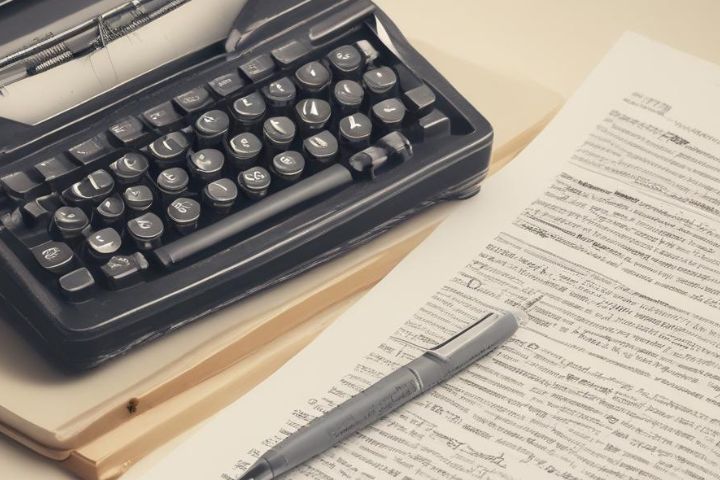
Editing and proofreading are essential stages in the writing process, each with distinct objectives and methodologies. Understanding the differences between editing vs proofreading is crucial for ensuring written communication’s overall quality and effectiveness. Let’s delve into a detailed comparison:
1. Focus: Content vs. Surface Errors:
- Focuses on refining the content, structure, and style of the text.
- It involves analyzing the overall coherence, clarity, and effectiveness of the narrative or argument.
- Addresses plot development, character consistency, logical flow, and thematic coherence.
- It may require substantial revisions, additions, or deletions to enhance the overall quality and impact of the manuscript.
Proofreading
- Focuses on identifying and correcting surface-level errors, such as spelling, grammatical, punctuation, and typographical errors.
- Involves scrutiny of individual words, sentences, and paragraphs to ensure accuracy and consistency.
- Does not typically involve making significant changes to the content or structure of the text but rather focuses on polishing the final draft to eliminate errors and enhance readability.
2. Timing: Before vs. After the Final Draft:
- Typically, it occurs before the final draft is prepared.
- Involves multiple rounds of review and revision throughout the writing process, from the initial draft to manuscript completion.
- Allows substantive changes to be made to the text's content, structure, and organization to improve its overall quality and effectiveness.
- Typically occurs after the final draft has been prepared and edited.
- Involves a final manuscript review to ensure it is error-free and ready for publication.
- Focuses on fine-tuning the final draft by correcting any remaining surface-level errors and inconsistencies before distribution.
3. Goals: Improving Structure and Coherence vs. Correcting Grammar and Punctuation:
- The goal is to improve the text's structure, coherence, and overall quality.
- Aim to enhance the narrative flow, logical progression of ideas, and thematic consistency.
- Focuses on refining the language, tone, and style to effectively engage the audience and convey the intended message.
- The goal is to correct grammar, punctuation, spelling, and typographical errors.
- Aims to ensure consistency and accuracy in language usage and formatting.
- Focuses on eliminating distractions and enhancing readability by polishing the final draft to meet the highest linguistic precision and professionalism standards.
4. Skills Required: Analytical vs. Detail-Oriented:
- Requires strong analytical skills to critically evaluate the text's content, structure, and coherence.
- It involves identifying strengths and weaknesses in the writing and providing constructive feedback for improvement.
- Requires a deep understanding of storytelling techniques, narrative structure, and audience engagement strategies.
- Requires strong attention to detail to identify and correct surface-level errors accurately.
- Involves review and comparison of individual words, phrases, and punctuation marks.
- Requires a thorough knowledge of grammar, punctuation rules, spelling conventions, and style guidelines.
When to Use Editing vs Proofreading Services

When to Use Proofreading Services
- Final Drafts: When the content has already undergone substantial editing and revisions, proofreading ensures that no lingering errors remain before publication.
- Time Constraints: In situations with limited time available for thorough editing, proofreading can quickly address glaring mistakes without extensive restructuring or rewriting.
- Minor Corrections: For documents that require only minor adjustments or corrections to grammar, punctuation, and spelling, proofreading provides a cost-effective and efficient solution.
- Requires a thorouRoutine Content: Regularly produced content such as blog posts, newsletters, or social media updates may benefit from regular proofreading to maintain professionalism and credibility.gh knowledge of grammar, punctuation rules, spelling conventions, and style guidelines.
When to Use Editing Services
Editing is preferred when the text requires more substantial structure, content, or language changes to improve clarity, coherence, and overall quality. Some situations where editing is necessary include:
- Initial Drafts: When the content is still in the early stages of development, editing helps refine ideas, improve organization, and strengthen the overall narrative or argument.
- Complex Content: Documents with complex subject matter or technical language often require extensive editing to ensure accuracy, coherence, and readability for the target audience.
- Significant Revisions: When feedback suggests significant revisions are necessary, editing provides the opportunity to restructure content, refine arguments, and address any inconsistencies or gaps in logic.
- Professional Publications: Manuscripts intended for publication in academic journals, books, or other professional outlets typically undergo multiple rounds of editing to meet rigorous standards of quality and scholarship.
Combination Approaches
In many cases, a combination of proofreading and editing may be the most effective approach to ensure the highest quality of written work. Combining both services allows for a comprehensive review that addresses both surface-level errors and deeper structural issues. Some scenarios where a combination approach is beneficial include:
- Comprehensive Editing: For documents requiring extensive revisions, starting with substantive editing followed by proofreading ensures thorough attention to content and presentation.
- Final Quality Check: Even after extensive editing, a final round of proofreading helps catch any remaining errors or inconsistencies before publication.
- Collaborative Projects: In collaborative writing projects, combining proofreading and editing ensures consistency in style, tone, and content across different sections or contributions.
- Multistage Process: Breaking down the writing and revision process into multiple stages, with editing and proofreading at each stage, helps maintain clarity and coherence while minimizing errors.
Final Thoughts
Proofreading and editing are both crucial steps in the writing process. It is important to understand the key differences between them. Proofreading focuses on correcting grammar, punctuation, and spelling errors, ensuring clarity and consistency in the text. On the other hand, editing involves a more comprehensive review of the writing’s content, structure, and overall flow. By recognizing these distinctions, writers can enhance their work’s quality and communicate their message more effectively. Whether you want to refine a document for professional purposes or improve your writing skills, mastering both proofreading and editing techniques is essential for producing polished and engaging content. Incorporating these practices into your writing routine will help you avoid common mistakes and elevate your writing to a higher standard of excellence.
Get a Quote
We offer industry leading publishing services for all of your book writing needs
Have any queries regarding our award-winning services? Connect with us now via live chat or call.
- 112 West 34th Street 18th & 17th Floors New York, NY 10120
- +1(425) 272-5279
Useful Links
- E-book writing
- Book Publishing
- Book Marketing
- Book Cover Design
- Book Editing
- Book Proofreading Services

- Copyrights 2023, Swift Book Publishing, All Rights Reserved
- Term & Condition
- Privacy Policy
Request A Quote
Services Select Option Book Editing Book Trailer Book Audio Book Proofreading Services Book Cover Design Book Marketing Book Publishing E-book Writing
- Link to facebook
- Link to linkedin
- Link to twitter
- Link to youtube
- Knowledge Hub
Copy Editing vs. Proofreading: What’s the Difference?
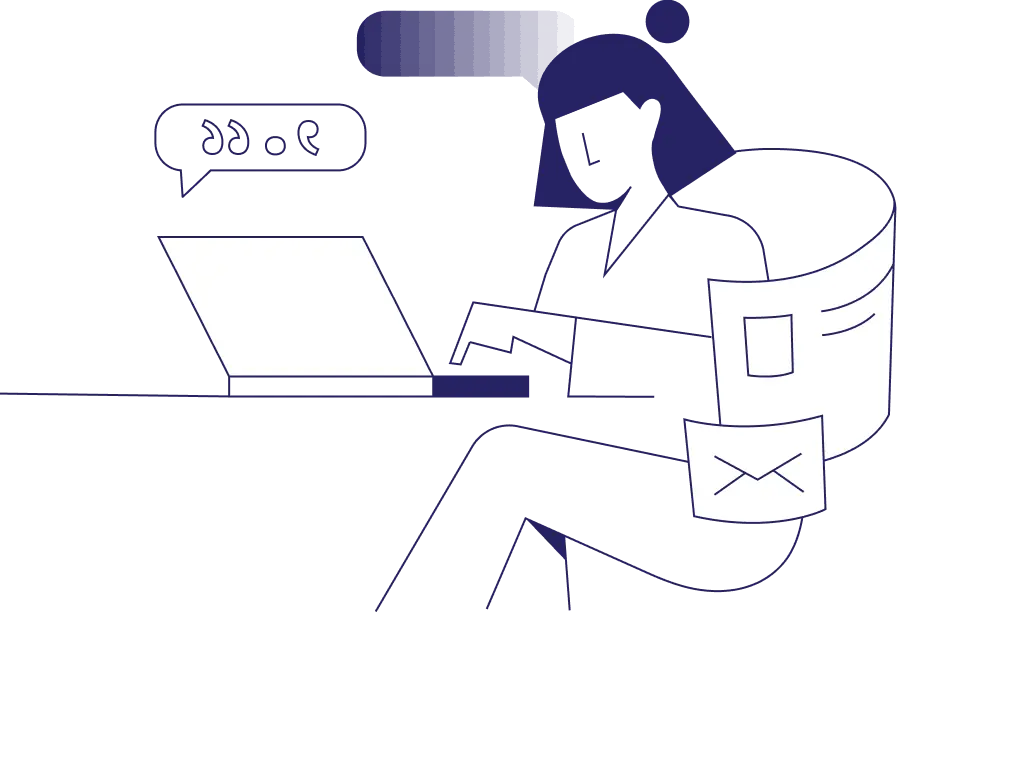
- 6-minute read
- 29th September 2023
As an e-commerce business, your website content matters. Good content not only drives traffic to your business’s site, but it moves leads through the sales pipeline. Copy editing and proofreading your content can help you save funds in the long run and grow your business .
But what’s the difference between copy editing and proofreading, and where do they sit in the content marketing process? In this guide, we’ll define these two distinct services and show you why prioritizing them can help you create effective content that reflects your business’s brand voice and increases sales. Keep reading to learn all about copy editing vs. proofreading and how your business can start publishing high-quality content today.
- What Is Copy Editing?
Copy editing for businesses means ensuring that all published content is clear, accurate, organized, and meets your established style guidelines. It is different from copywriting and content writing, as it focuses more on editing existing content rather than creating it from scratch. It’s also different from developmental editing , which usually involves major structural and organizational changes.
Copy editing goes beyond checking for surface-level issues, and some rewriting and refining of the content may be necessary. Some issues that copy editors check for are:
- Abrupt shifts in tone or point of view
- Inconsistent or incorrect brand voice application
- Factual inaccuracies
- Adherence to style guidelines
- Unclear or confusing text
- Logical flow of ideas
- Awkward paragraph transitions
One of the main goals of copy editing is ensuring that content appeals to your target audience. For example, copy editors check that the language formality matches your brand voice and resonates with your customer base. They can also help eliminate monotonous or repetitive language and verify that certain vocabulary choices make sense in the context.
What Is Proofreading?
Proofreading is the last step in the content production process before publication. That means no major structural shifts, changes in tone of voice, or additions to content occur at this stage. Instead, proofreaders check for:
- Grammatical and/or punctuation errors
- Misspellings or typos
- Sentence structure issues, such as misplaced modifiers
- Inconsistencies, such as with capitalization
- Incorrect dialect usage
- Accurate numbering and date formats
Proofreading business content is about more than just catching errors and inconsistencies. Skilled proofreaders can read text such as website content, email campaigns, and product descriptions with a keen eye for detail and suggest subtle but impactful improvements.
For example, proofreaders can check for distracting formatting issues, such as unnecessary font changes. They can also flag other issues that could hurt your conversion rate, such as overuse of technical jargon, confusing acronyms, and factors affecting SEO optimization .
Copy Editing vs. Proofreading Business Content
While copy editing and proofreading can overlap somewhat, they are two distinct steps in the publication process with several key differences.
Copy editing is a more comprehensive review of the content that ensures clarity, coherence, accuracy, and overall quality. It involves not only correcting errors but also improving the overall flow and organization of the material. This is especially important if you use AI technology to assist in your content marketing , as the content these tools produce needs thorough editing to improve the general tone and readability before publication.
Proofreading is a final check to catch any remaining mistakes before the content is shared with clients, stakeholders, or the public. It’s especially significant for marketing materials where minor errors can stand out and negatively impact credibility.
Why You Need Both Copy Editing and Proofreading
For business writing, both copy editing and proofreading are essential to maintain a professional image and effectively convey your message – whether you’re selling a product or service.
Your business’s website content is the first thing customers notice after landing on your page, so it needs to leave a lasting first impression and make an impact. Proofreading for business content targets things like surface-level grammar/spelling issues and minor formatting discrepancies. It prevents companies from publishing content that’s hard to read or riddled with unprofessional errors, which can lower confidence in your business. In a study done by Tidio , 97% of respondents report that grammar mistakes affect their perception of a company.
Copy editing goes deeper into content enhancement and organization and ensures the content you put out flows well, reflects your company’s style guide , and is factually accurate. And if your business operates internationally, copy editing can ensure that your content is well-adapted to different cultural and linguistic contexts, expanding your global reach.
Proofreading and copy editing ensure your content is clear and concise, which is crucial for grabbing and keeping the attention of potential customers.
Outsource Editing Services to Maximize Your Resources
Proofreading and copy editing are essential for successful businesses – but both require a significant investment of time and resources. Outsourcing editing tasks allows your in-house team to focus on core business activities that directly contribute to your company’s objectives. This can lead to increased productivity and efficiency, as your team members can channel their energy into tasks that align with their expertise.
Outsourcing editing also provides flexibility to scale up or down based on your editing needs. During periods of higher content production , you can easily increase the volume sent to the editing service without the hassle and cost of hiring and training new employees. You only pay for proofreading and editing services when your business needs them.
Finally, professional editing services often have a dedicated freelance team based in a wide range of countries and time zones, which can lead to faster turnaround times. This is especially beneficial when you’re working with tight deadlines or need to respond quickly to market changes to gain a competitive advantage.
To summarize, proofreading and copy editing are both crucial aspects of content production and shouldn’t be overlooked to save time or resources. Our team has experience proofreading and editing a wide range of business content, from landing pages to business reports, and can help ensure you’re consistently publishing first-rate, highly effective content . Take the first step and schedule a call today to discuss your business needs.
Jump to Section
Share this article:, want to save time on your content editing, our expert proofreaders have you covered., learn more about proofreading & editing.
- The Role of AI in Multilingual Content Editing and Localization
- How to Outsource Your Copy Editing for Content Growth and Scalability
- How to Choose the Right Type of Grant Proposal + Tips
- Five Signs It’s Time to Invest in Professional Proofreading
- The Dos and Don'ts of Proofreading for Legal Documents
- Data Storytelling: What It Is and How to Ace It
- The Benefits of Fact-Checking Your Content
- Your Guide to Efficient Enterprise Copy Editing
- Copyediting Versus Line Editing: What’s the Difference?
- How to Edit Grant Applications – and Increase Your Chance of Success
- How to Copyedit Anything Step by Step
- What Is Developmental Editing?
- Top Tips for Training Editors on Your Team
- How Proofed Slashed Delivery Times for IoT Analytics
- How the Linux Foundation Streamlined Their Editorial Process
Looking For The Perfect Partner?
Let’s talk about the support you need.
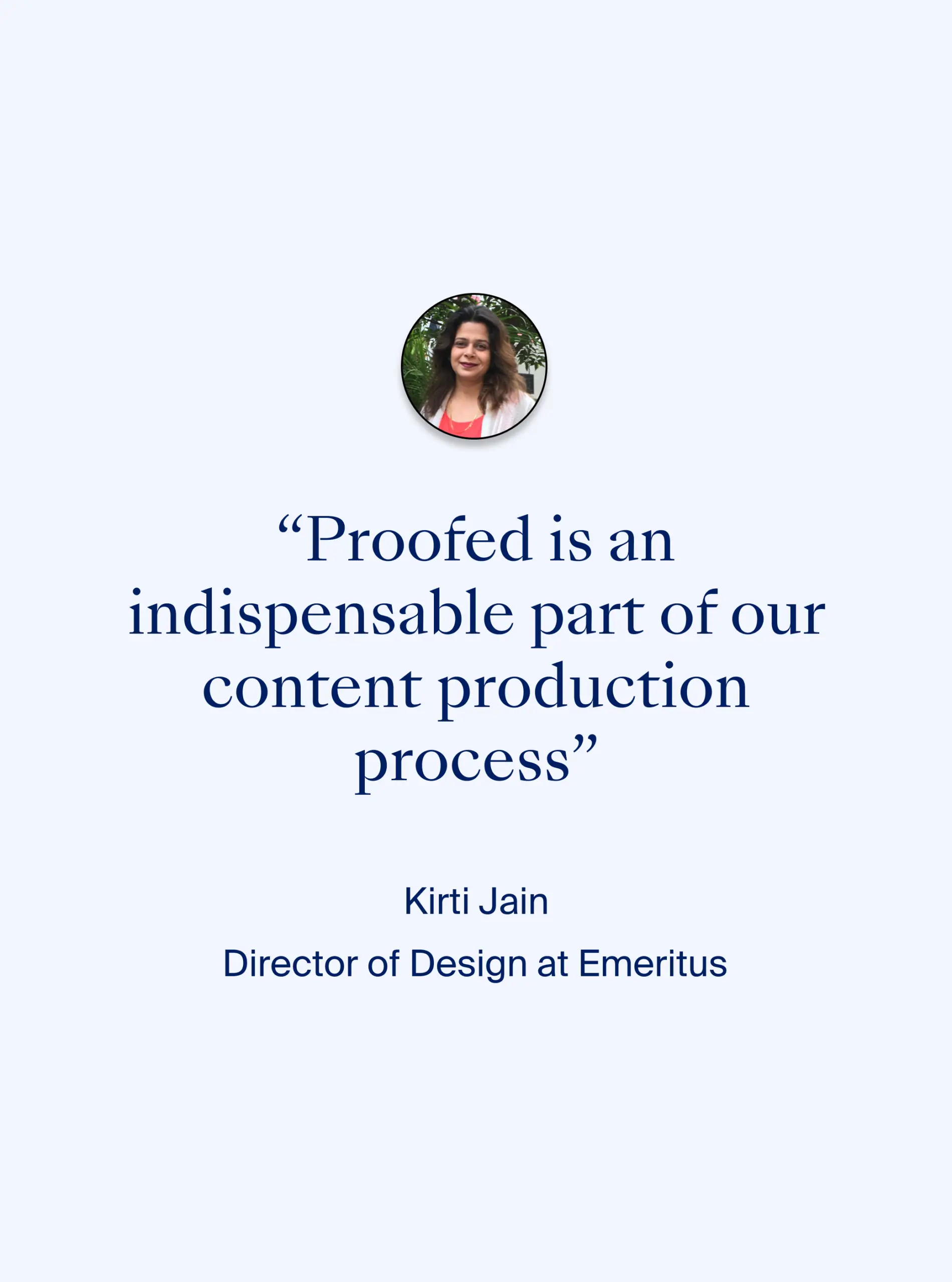
Book a call with a Proofed expert today
Editing vs Proofreading
| Candace Osmond
Candace Osmond
Candace Osmond studied Advanced Writing & Editing Essentials at MHC. She’s been an International and USA TODAY Bestselling Author for over a decade. And she’s worked as an Editor for several mid-sized publications. Candace has a keen eye for content editing and a high degree of expertise in Fiction.
Any competent writer knows that their writing needs to undergo editing or proofreading regardless of their expert writing skills. Do you need some kind of editor or a simple proofreader? It took me years to learn that answer for myself.
Whether you’re writing a book, term paper, or a personal document, proofreading and editing lead to different outcomes for writers. Find out the difference between an editor vs. a proofreader.
Editor vs. Proofreader
The work of the editor and proofreader are separate in the traditional publishing industry. Yes, the line between both is blurring; here’s the difference between editing and proofreading in the English language.
Focuses on more comprehensive errors in writing
Conformity with the writing style and language clarity
Removes inconsistencies and redundancies
Fixes your writing quality and tone
Checks character development, plot, and theme in fiction writing
Checks if persuasive writing is persuasive enough
Ensures politeness and gender-inclusive language
Proofreader
Fixes spelling and typographic errors
Ensures your piece of writing adheres to grammar rules
Fixes punctuation mistakes for quality writing
Consistent notation and formatting of page numbers
Checks for common errors in running heads, table of contents, references, tables, and illustrations.
Double-checks word breaks
Querying any layout
There are different types of writers that choose between editing and proofreading. For example, most academics who are confident writers only need proofreading to remove mistakes in spelling and grammar.
An English as a Second Language writer may need editing because they need to correct more than grammatical errors. They might also require assistance with the cohesion and coherence of their writing and their conciseness.
If you’re a book author or business writer, you may need editing and proofreading for your work. These two stages will lead to a mistake-free, high-quality document.
However, no hard-and-fast rules exist on which service they should get. The best editing and proofreading company should offer both to clients.
Editing Explained
The term editing isn’t about correcting errors in spelling or grammar but improving the overall quality of your English writing. Aside from the formal writing conventions, editing focuses on the clarity, creativity, and tone of every sentence.
A professional editing company offers different types of editing, like academic editing and translation editing of any document. But here are some possible factors to consider:
- Fixing inconsistency in language.
- Changing from passive voice to active .
- Adjusting the tone according to the audience.
- Making a persuasive essay more persuasive.
- Ensuring that fiction writers show proper character development and storyline.
This process occurs before proofreading, playing a vital role in delivering your ideas. Editing also involves taking a closer look at the writing issues of your content using theories and facts from the subject.

Once you’re done editing, your work should look and sound flawless, even if you’re a non-native English speaker. Your work is ready for proofreading. You may now check your writing for spelling, grammar, and punctuation errors.
Proofreader Explained
Many language experts consider proofreading a science because it’s a systematic method based on the consistent rules of English. Proofreaders check documents for mistakes in spelling, grammar, punctuation, inconsistent terminology, and formatting before publication.
Proper proofreading tends to focus on correcting surface errors in writing, but it still requires specialized knowledge. Enough experience is also essential in professional proofreading to ensure the quality of writing.
These qualifications cannot be replaced by any person or online spell checker tool since humans can automatically correct errors in our brains.
Have you ever tried to read a jumbled word so quickly that you don’t notice the typo? That’s one reason to get a professional proofreader.
Proofreading occurs after editing the work for tone, sentence length, and clarity. The final manuscript is analyzed one last time before being submitted to the publishing house .
Any written work needs proofreading services to ensure success in producing a mistake-free document. Whether you’re writing business documents or an academic essay , your piece of writing may be prone to structural errors.
What is the Big Difference Between Copy Editing and Proofreading?
Copy editing and proofreading both ensure that the writing adheres to cursory spelling, grammar, and capitalization rules. The most significant difference lies in the type of document being used and the delivery time to the proofreader or editor.
Copy editing is part of the revision process that checks grammar and spelling errors before proofreading . A freelance editor may rewrite some individual sentences or paragraphs on your initial draft to improve the piece.
This part of the editing process also includes checking for transitions between paragraphs and jargon. It also checks your work for wordiness and complex sentences.
Proofreading occurs once you have the final draft or manuscript with all the designs and formatting. This step may also include the consultation of an online grammar checker to guarantee perfection before publication.
The proofreader works with the “proof” to look for formatting and numbering errors until the whole work is publication quality.
Tips for Editing
Here are some editing tips to make the entire writing process more manageable.
Does your essay include an introduction and conclusion? If you’re a fiction writer, does your story have an exposition and denouement? A proactive editor makes sure each paragraph is clear and related to the overall story.
Another editing tip to make your writing clearer is checking the logical sequence of your work. Make sure you’re using the correct number of transitional devices between paragraphs.
Editing concentrates on the core features of elements of writing. First, you need to ensure your article includes accurate claims and arguments. Your statements should also be complete with supporting details if you’re doing non-fiction or journalistic writing.
The style of your writing is in charge of the author’s voice. Make sure you insert your personal style without committing language mistakes.
Expert editors use appropriate gendered language. Check the length and structure of your sentence and if everything is in active voice.
You can also have a random person read your work to provide a fresh pair of eyes on your work.
Tips for Proofreading
Proofreading may seem easy because it only looks for objective language errors, but there are many rules to consider.
Don’t Rely on Grammar and Spell Checkers
Sometimes, online editing software is enough for daily writing . But term papers and other critical writings require intensive proofreading by a professional.
Manually check the actual document for grammar errors and typos. Some spelling checkers cannot detect if a piece of punctuation has incorrect placement. They also can’t tell the difference between “your” and “you’re.”
Read our review on Grammarly here .
Proofread One at a Time
Do not revise several error types at once. Try reading the whole text and looking for spelling issues first. Then, have another look at the document for grammatical errors.
Keep doing this for formatting, punctuation, and design to make sure your piece of writing meets publication standards.
Read the Paper Backwards
Reading your paper backward helps you check your spelling more effectively. Begin with the final word on the last page and read each word separately.
Which Service Do You Need?
I hope my article helped you make an informed choice between editing vs. proofreading service. Remember that editing occurs on the first draft, while proofreading is the final phase before publication.
If you’re experiencing difficulty choosing between the two, you can find combined editing and proofreading services in editing companies.
Grammarist is a participant in the Amazon Services LLC Associates Program, an affiliate advertising program designed to provide a means for sites to earn advertising fees by advertising and linking to Amazon.com. When you buy via the links on our site, we may earn an affiliate commission at no cost to you.
2024 © Grammarist, a Found First Marketing company. All rights reserved.
Become a Bestseller
Follow our 5-step publishing path.
Fundamentals of Fiction & Story
Bring your story to life with a proven plan.
Market Your Book
Learn how to sell more copies.
Edit Your Book
Get professional editing support.
Author Advantage Accelerator Nonfiction
Grow your business, authority, and income.
Author Advantage Accelerator Fiction
Become a full-time fiction author.
Author Accelerator Elite
Take the fast-track to publishing success.
Take the Quiz
Let us pair you with the right fit.
Free Copy of Published.
Book title generator, nonfiction outline template, writing software quiz, book royalties calculator.
Learn how to write your book
Learn how to edit your book
Learn how to self-publish your book
Learn how to sell more books
Learn how to grow your business
Learn about self-help books
Learn about nonfiction writing
Learn about fiction writing
How to Get An ISBN Number
A Beginner’s Guide to Self-Publishing
How Much Do Self-Published Authors Make on Amazon?
Book Template: 9 Free Layouts
How to Write a Book in 12 Steps
The 15 Best Book Writing Software Tools
What Is Copy Editing?: The Ultimate Copy Editing Guide
POSTED ON Oct 25, 2023
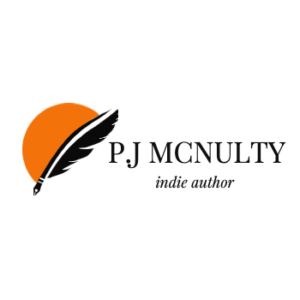
Written by P.J McNulty
Copy editing. Copyediting. Copy-editing. No matter which format you prefer to use, each one is in reference to the same type of editing.
Many writers and aspiring authors looking to self-publish their book have a variety of questions around copy editing, and we're here to help answer them. What is copyediting? What is the difference between copy editing vs line editing? What should you expect once you find a book editor for your project? Let's dive into all the details of this important step in the book publishing process.

This blog on copy editing will cover:
What is copyediting.
By definition, copy editing is the process of reviewing your work before publication by correcting mistakes, checking for inaccuracies, and preventing repetition in your writing.
The Webster’s Dictionary definition is:
“An editor who prepares copy for the typesetter.”
That’s a vague definition, so let’s break it down by explaining what exactly a copy editor does.
A copy edit is the lowest level of edit. Rarely does a manuscript need “just” a copy edit.
Sometimes a copy edit is a final step performed separately by your editor or someone else with fresh eyes. Some editors (like me) do copy editing along the entire process looking to fix these types of errors.
Copy editing involves the following tasks:
- Correct any typos , which would include misspelled words.
- Fill in missing words.
- Format the manuscript before production , and that includes just one space between sentences (I don’t care what you learned in typing class in high school, the double space messes up the document when it is converted into real book pages).
- Streamline punctuation and properly use commas, periods, and em dashes. Avoid overuse of ellipses to denote a break in thought…when they are really used to show missing text. And those exclamations marks! I allow authors about five in each manuscript. Overuse them, and they lose their punch. (I removed thousands of exclamation marks in one book I edited.)
- Make sure the names of characters and places are spelled consistently throughout. (Peterson in Chapter 1 may or may not be the same Petersen in Chapter 6).
- Find and replace similarly sounding words with far different meanings (affect/effect, their/there, and its/it’s are mistakenly used).
- Conduct a modest fact check (perform a Google search to find the exact spelling of Katharine Hepburn or the capital of Mongolia). This isn’t Jeopardy! , so you do get to consult resources. I keep a window open to Google just for such searches.
- Make new paragraphs to break up long passages .
- Question the use of song lyrics and remind the author to get written permission.
- Call attention to missing reference sources in the citations.
- Remove overuse of quotation marks . For emphasis, use italics , but sparingly. Books generally do not use boldface and never underline.
- Impose a consistent style for the text (this means using a style guide for capitalization and hyphenation, treatment of numbers, and heading levels). The Chicago Manual of Style is preferred unless the work needs to conform to an academic convention such as APA, AMA, or MLA.
So, what is copy editing? By now, you should hopefully have a solid understanding of all that a copy editor would do when it comes to editing your book and preparing it to be published. But it's important to understand how copy editing differs from other styles of editing .
These are the different types of edits:
- Line editing and copy editing are often used to signify the lower levels of editing (meaning the editor tinkers with the sentences and words). I will explain the differences between these two types of editing below.
- Developmental and substantive editing describe more drastic changes and suggestions.
- Proofreading is an entirely different step in book production that corrects absolute error when the book is in final page proofs.
Is copy editing necessary?
Yes. In short, editing is important because readers expect and deserve a clean read.
When you have a thoroughly edited fiction novel or nonfiction book , readers are better able to enjoy your character development and poignant scenes instead of getting hung up on misspelled words and clunky punctuation.
The fact of the matter is that poorly edited writing almost always turns readers away, and most readers aren’t forgiving when the errors in your writing distract them from your story.
Editing helps you avoid the cruel (but often true) Amazon kiss-of-death reviews that say “needed an editor” or “should have used spellcheck.”
Reasons why copy editing is necessary:
- It improves the reader’s experience
- It makes your writing better
- It helps people take your books seriously (and want to buy them!)
Are we editors perfect? Never. But we can get close.
And that’s exactly why editing is necessary – it helps us get your writing close to perfect.
Those pesky typos can turn up where we least expect them and cause many a conscientious editor to wake up in a cold sweat over a point of grammar, only to turn to our well-worn copy of the Chicago Manual of Style , the industry bible and arbiter of all things editing.
New authors are often confused about what level of editing they need, and rightly so. With so many variations of editing, and a sea of editors specializing in one type of edit, it can be difficult to keep track.
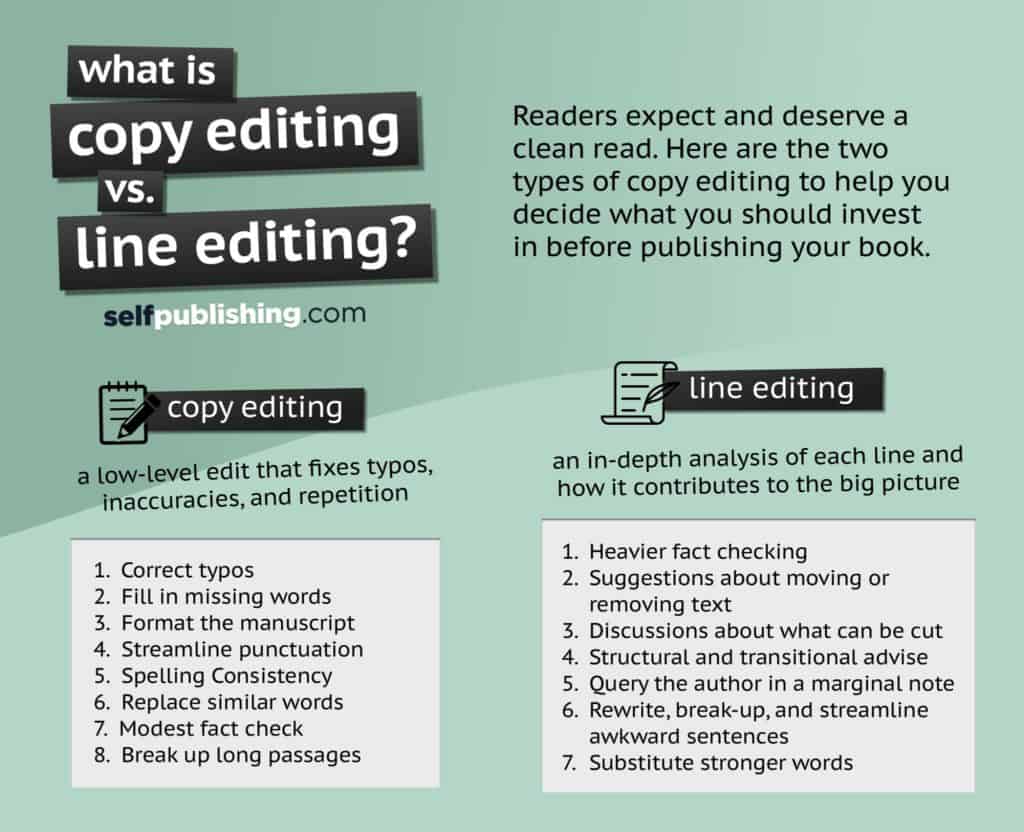
Copy editing vs line editing
When it comes to understanding copy editing vs line editing, there seems to be some gray matter and overlap.
For guidance on defining copy editing as it differentiates from line editing, I turned to the all-knowing authority, the Chicago manual. Yet even that widely accepted authority doesn’t make a distinction among editing levels:
“Manuscript editing, also called copyediting or line editing, requires attention to every word and mark of punctuation in a manuscript, a thorough knowledge of the style to be followed, and the ability to make quick, logical, and defensible decisions.” See chapter 2 in the Chicago Manual of Style
For purposes of this blog post, let me attempt to explain the thin red line between line editing and copy editing.
Spoiler alert : not much difference.
Similar but still very different, a copy edit is a low-level edit that fixes typos, inaccuracies, and repetition, while a line edit is basically a deeper, line-by-line version of a copy edit.
Copy editing is a surface-level edit, while line editing takes it deeper. Line editing focuses on how you are communicating your ideas by analyzing the construction of your writing closely, line-by-line.
In line editing, the editor looks at how your ideas are communicated through your writing by conducting an in-depth analysis of each line and how it contributes to the big picture.
To clarify the difference between copy editing vs line editing, let's look at some tangible examples of tasks a line edit might include.
A line edit covers all the editing tasks on my checklist for a copy edit, plus a deeper sentence-level look at additional fixes.
Line editing includes these tasks, whereas copy editing does not:
- Heavier fact checking (for example, exact titles of movies in italics, death date of a famous person in history, the protagonist using an iPhone before they were invented).
- Suggestions about moving or removing text (or actually doing the task and explaining why in a marginal note).
- Initiating discussions about what can be cut , such as the dreary Introduction.
- Offering a new scheme for moving a chapter or two around to better accommodate a timeline. (Actually doing the moving and writing transitions might fall into the category of developmental edit.)
- Querying the author in a marginal note about why Susan in Chapter 2 was wearing a winter coat when the scene takes place in summer. Or whether the author intended for the detective described earlier with a full beard to be scratching his stubble.
- Rewriting awkward sentences, breaking up long sentences, or streamlining sentences with clauses and parenthetical phrases. A line editor may recast sentences that begin with There are and It is . Those constructions are simply not strong. That’s why line editing is considered a sentence-level type of edit.
- Substituting stronger words for commonly overused words ( very, pretty, things, great, really, and good are my pet peeves).
When asking a potential editor “What is a copy edit?” you might hear the term “proofread” used interchangeably as well. So, what's the actual difference there?
Copy editing vs proofreading
A copy edit focuses on fixing a wide range of mistakes, whereas proofreading focuses on small typographical errors and formatting issues, but does not suggest major changes.
A proofreader works with a “proof” – or a nearly finished product or work. Proofreading is typically conducted after the manuscript has been entirely edited and designed, as a final check before printing.
Copy editing is often used interchangeably with proofreading, because as you can see, there are some overlaps. But, if we were to explain it in terms of depth, a copy edit is a low-level edit, and a proofread is an even lower level edit.
Despite these differences, both types of edits are important, and if you’re hiring an editor to complete an in-depth edit on your manuscript, a copy edit and proofread will likely be included.
How to copy edit writing
As editors, we’re big on pushing our authors to “show, don’t tell.” So let me do the same.
The Word feature of Track Changes (under the Review tab) is the most powerful way to mark and exchange a document between author and editor. Some editors/authors are also working with Google Docs.
The following examples show how the mark-up looks in Word and the kinds of conversations the author and editor have in the margin.
Consider this example of a simple copyedit:
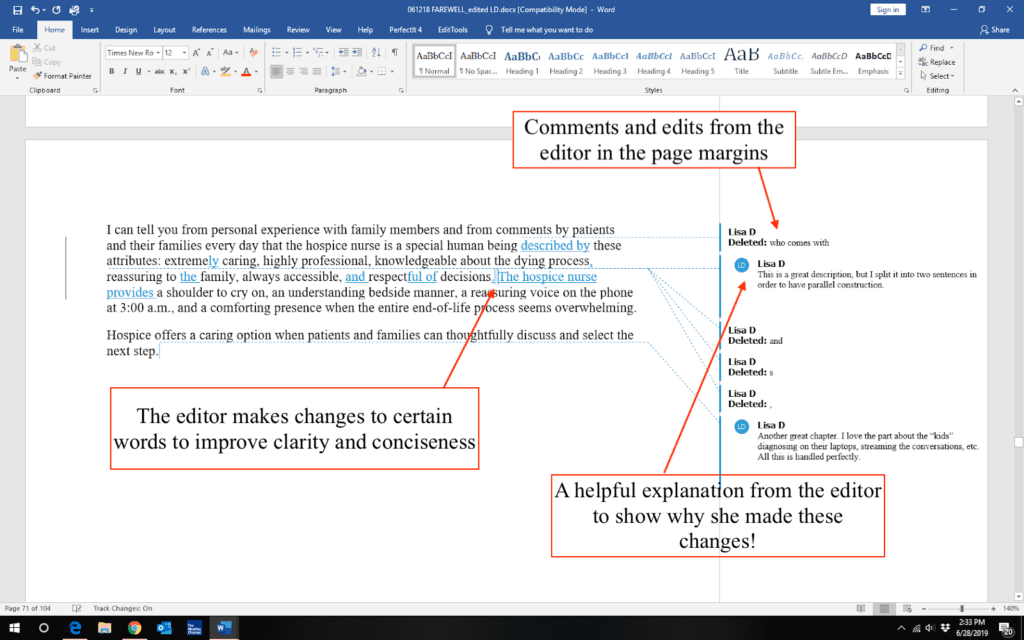
The editor has explained why she changed the wording of a sentence (to make the elements parallel). Explanation isn’t always necessary, of course, but in this case Lisa was justifying a fine point. She also offers a pat on the back with her last comment, which is always appreciated.
Eagle-eyed editors stray into the line editing side, with a deeper edit, and make observations like this:
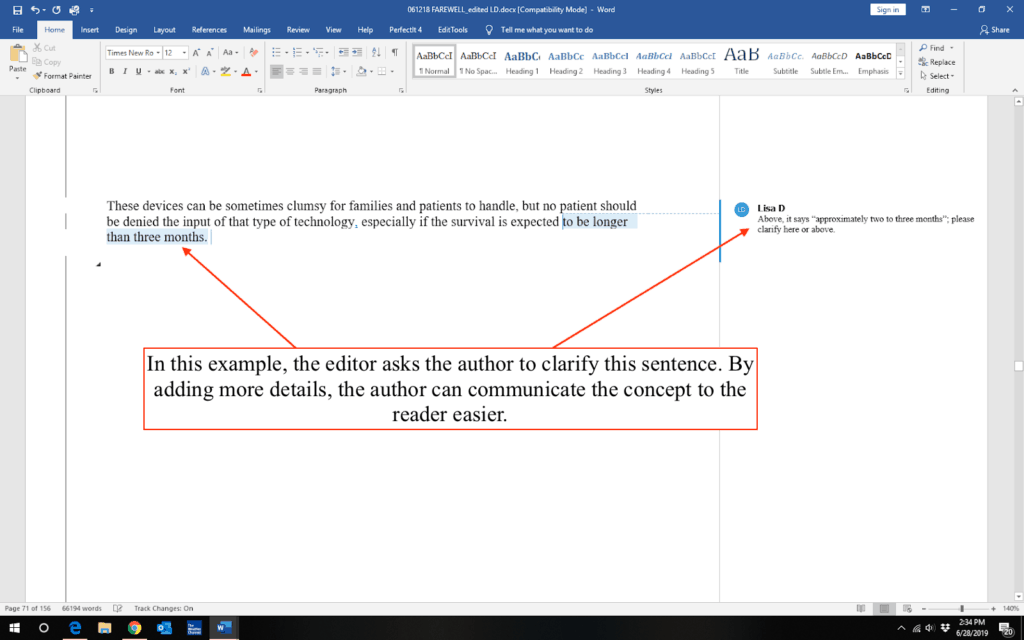
Line editors also smooth awkward sentences that aren’t necessarily wrong.
The line edit tinkers at the sentence level like this, but note that a line edit also performs the copy editing task, as noted in the last line where the editor supplied a missing word:
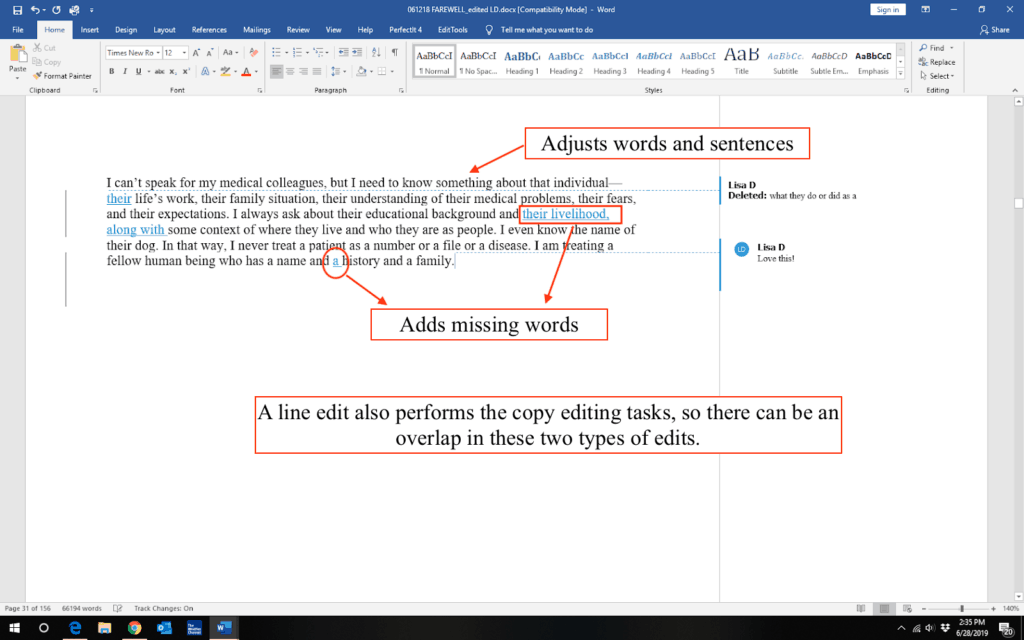
The bottom line is that line editing, in my view, is also a copy edit. Not only does a line editor adjust and reword sentences here and there, but also makes suggestions about global points.
Related: How to Become an Editor for Books
Should you copy edit your book?
While it might seem like there are many points of disagreement in the editing world, we editors do agree on one overriding principle, which is this:
Your manuscript deserves a professional and sound edit to make it free of typical errors of spelling and punctuation, with proper use of the right word, judicial paragraphing, logical chapter breaks and helpful chapter titles, prudent fact checking for accuracy—and, above all, consistency.
As Random House copy chief Benjamin Dreyer said in his exceptionally fascinating book, Dreyer’s English :
“My job is to lay my hands on that piece of writing and make it…better. Cleaner. Clearer. More efficient. Not to rewrite it…but to burnish and polish it and make it the best possible version of itself that it can be.”
Wouldn’t it be great —(oh, sorry, my pet peeve word). Wouldn’t it be helpful to have software that edits for you?
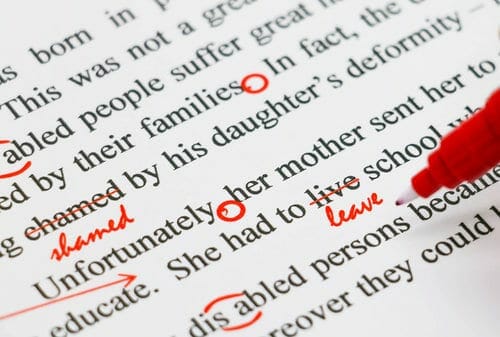
Sure, you can find book writing software that claims to help you edit, cut the extraneous words, suggest stronger words, flag inconsistency, denote caps in one place and lower case in another, and point out poor construction.
You can experiment with helpful tools like PerfectIt, Grammarly , and the built-in Spelling & Grammar checker in Word, but none are foolproof.
I suggest authors use the spelling check but disregard the grammar check. Even when Word and Google Docs underline words and phrases for you to consider, the suggestions are often wrong.
Until AI nails editing, nothing beats a real human with an eye for editing and style—and handy resources.
When I edit, I open my online unabridged Merriam-Webster dictionary (the preferred guide for books), the Chicago guide online, and Google to fact check.
I also have a cheat sheet for commonly looked-up words such as African American, cell phone, decision-maker, long-term as an adjective, side-by-side, workout as a noun but work out as a verb, and 6:00 a.m. to express time.
Can a machine do that?
How to work with a copy editor
Your editor is not (and should not be) a rigid tyrant. You are the author. Your name is on the front cover of your book.
Your editor is a professional who can guide you in writing the best book you can.
We’re also not your high school English teacher, so we will actually make editorial changes for you and leave you kind notes in the margin.
We’ll explain why you might consider different phrasing, and we’ll suggest alternative words for you.
We also don’t grade you, and your graduation doesn’t depend on your writing a sterling essay.
We know the rules of writing and can help you apply them .
But the question remains about which level of editing your manuscript needs. Use our expertise to decide and follow a few smart steps to come to an agreement with your editor before any proverbial red pencils hit the paper.
What to do when working with a copy editor:
- Submit your entire manuscript to an editor. We need to see the entire beast, not just the tail (which is usually your first chapter, often the most rewritten and thus cleaner).
- Let us evaluate the level of editing and pronounce a line edit or copy edit to move your work along toward publication.
- Ask an editor to perform a sample edit of, say, five pages or several hundred words. Then you can see the level of edit the editor is performing on your work. Let the editor choose where to draw that sample from (I randomly scroll and stop in the middle).
- Make sure the editor knows your goals for the edit. If you just want your words cleaned up, then you want a copy edit.
- If you’re not open to making changes or letting someone tinker with your words, then go with a copy edit.
- Be open to editorial suggestions but know that you have the final say.
- Know when you want to break the rules. Editors should be open to capitalizing key phrases in your industry, for example, even when Chicago style would not suggest caps.
What not to do when working with a copy editor:
Don’t expect editors to write best sellers.
If we could, I’d write one with my name on the front cover. Even though we are in the silk purse business, I’ve seen many sows’ ears that will never be silk purses.
A line edit and copy edit help you put your best work forward. I call it getting the mustard stains out of the blouse or tie, so they’re not distracting.
Don’t ask the editor, “Is this good?”
Here’s what I tell authors I work with: I can tell you if I enjoyed your story or the history or memoir or plot and characters . I am one person who may not be your target reader.
I can give you my opinion. If you want to test your work on the market of target readers, consider a beta reader process.
I can make your manuscript mechanically sound and ready for publication. The goal of a line edit or copy edit is not to create the next Pulitzer Prize–winning work.
It’s to help you be as close to error-free as possible.
Although we’ve conducted an analysis of copy editing, I hope you’re not feeling too overwhelmed.
Even if you don’t realize it now, the details will help you understand the big picture and prepare for your book’s editing process.
Now that you understand what copy editing is, as well as the difference between copy editing vs line editing vs proofreading, you’re better equipped to understand what type of edits your manuscript will need to prepare it for publishing.

Related posts
How to maximize your experience at author advantage live, how to unpublish a book on amazon: 5 reasons to consider first.
Business, Publishing
How To Get A Literary Agent in 13 Simple Steps

- Services for education institutions
- Academic subject areas
- Peer connection
- Evidence of Studiosity impact
- Case studies from our partners
- Research Hub
- The Tracey Bretag Integrity Prize
- The Studiosity Symposium
- Studiosity for English learners
- Video case studies
- Meet the online team
Academic Advisory Board
Meet the board.
- Social responsibility
- Meet the team
- Join the team

Proofreading vs editing: What's the difference?
Evelyn Levisohn
Apr 10, 2019

Just finished writing your dissertation or essay? Congratulations! However, there's still a little way to go before you can hand it in. It's always essential to check over any piece of work to make sure you have the best chance of success. But should you edit your essay, or proofread it, or both? Many people use these terms interchangeably, however proofreading and editing don't quite mean the same thing - and they won't produce the same results.
Proofreading is the correcting of surface errors such as grammar, spelling and punctuation. While it still requires a nuanced understanding of the English language, it differs from editing, which seeks to improve the overall quality of writing by enhancing flow, readability and structure.
Here's a deeper look at what each involves.

Proofreading
Proofreading is often considered a science. Proofreading checks work to identify all errors in spelling, punctuation and grammar. It also picks up instances of inconsistent terminology, formatting and referencing. Proofreading tends to result in minor, aesthetic adjustments to text rather than big changes.
However, proper proofreading still requires specialised knowledge and experience to be effective (and certainly goes far beyond what your computer's spell-checking software can do). This is because the human brain is very good at correcting errors automatically, so when you look at a piece of writing you may not register its mistakes, especially when it comes to your own work. We've all seen those memes where some letters are jumbled up inside words, but you can still somehow read them!
Any assignment should include a proofreading stage to ensure it is error free before it's marked. Proofreading is also an opportunity for you to start recognising errors you make consistently so that you can avoid those mistakes in future .

If proofreading is a science, editing is an art. Editing is the process of improving the overall quality of writing to make an essay the best it can possibly be. It uses much more creativity and often considers the feelings of the work's audience. As such, editing can cause extensive changes to text, bringing up questions such as:
- Have you chosen the most appropriate words to convey your meaning effectively?
- Have you used the passive voice?
- Is the tone right for the audience?
- Are there unnecessary words or overlong sentences?
- Can the structure of the essay be changed to make the argument more persuasive ?
Editing is all about making sure the meaning and ideas in a piece of work are conveyed in the best possible way, for the audience. Editing might also involve looking more closely at the content itself, using specialist knowledge of the subject to clarify text, and often check facts as well. In addition, it's another chance to look closely at spelling and grammar, just as with proofreading.
When editing your own work, it's best to put it aside for a day or two so you can look at it with a fresh perspective (or with the added help of feedback from someone else). Otherwise, you are usually too attached to the assignment to be able to make objective decisions about the words on the page and the structure that you've used.
A popular technique of the drafting process is to edit first and proofread last, as a final, final step before you hand in your work. And definitely reach out for help during this process, if you can. A second set of eyes can be invaluable, for both editing and proofreading.
Online essay feedback in less than 24 hours
Studiosity's Writing Feedback service helps with both editing and proofreading your own work. When you have read and re-read your writing over and over, it can be very hard to find mistakes or to see clear ways to improve your overall assignment.
Our writing specialists are available 24 hours a day, 365 days of the year to review your written drafts. Their feedback will help you identify spelling and grammatical errors (including ones you might be making often without realising), structural issues, punctuation, and other core areas of academic literacy such as referencing that could be preventing you from getting your best marks.
With a detailed written guidance and pointers alongside highlighted, in-text annotations throughout your actual document, our specialists use examples from within your own work to illustrate their feedback. It can help you tackle both the editing and proofreading stages of improving your work before you hand it in for marking. And what's more, we'll send your draft back to you in under 24 hours, so you can meet even the tightest deadlines!
The best part? You may already have access to Studiosity for free , thanks to your education provider!

Topics: Students , English , Writing , Formative feedback
About Studiosity
Asking for feedback on your work is an essential part of learning. So when you want to better understand a concept or check you're on the right track, we're here for you.
Find out if you have free access through your institution here .
Recent Posts
Posts by topic.
- Students (85)
- Higher education (63)
- Student Experience (46)
- University (46)
- Education (41)
- online study (34)
- Learning (28)
- Tertiary education (28)
- Educators (27)
- Interview (24)
- Research (24)
- Parents (23)
- English (18)
- High School (18)
- Technology (17)
- students first (17)
- Writing (16)
- Podcast (14)
- Student stories (14)
- Homework (13)
- Assignment Help (12)
- Education policy (12)
- Formative feedback (12)
- Literacy (12)
- academic integrity (12)
- student wellbeing (12)
- Events (11)
- Academic Advisory Board (10)
- Studiosity (10)
- covid19 (10)
- international student (10)
- Australia (9)
- Health and Wellbeing (9)
- Learning trends (9)
- Student satisfaction (9)
- Teaching (9)
- Secondary education (8)
- Equality (7)
- Science (7)
- Student retention (7)
- UK students (7)
- staff wellbeing (7)
- Student support (6)
- UK Higher Education (6)
- academic services (6)
- online learning (6)
- CanHigherEd (5)
- Online Tutoring (5)
- Workload (5)
- belonging (5)
- CVs and cover letters (4)
- Internet (4)
- Mathematics (4)
- Partnerships (4)
- School holidays (4)
- Student performance (4)
- Widening Participation (4)
- student success (4)
- #InthisTogether (3)
- Grammar (3)
- University of Exeter (3)
- teaching & learning (3)
- Charity (2)
- Government (2)
- Mentors (2)
- Primary education (2)
- Subject Specialists (2)
- accessibility (2)
- community (2)
- diversity (2)
- plagiarism prevention (2)
- student stress (2)
- webinar (2)
- Biology (1)
- Careers (1)
- Chemistry (1)
- EU students (1)
- First years (1)
- Indigenous Strategy (1)
- Nutrition (1)
- Teacher (1)
- academic support (1)
- academic writing (1)
- business schools (1)
- choice of language (1)
- dyslexia (1)
- ethical AI (1)
- job help (1)
- library services (1)
- podcasts (1)
- reflection (1)
- university of west of england (1)
- July 2015 (12)
- March 2020 (11)
- June 2020 (10)
- July 2020 (8)
- September 2020 (8)
- March 2015 (7)
- April 2015 (7)
- October 2019 (7)
- April 2020 (7)
- May 2018 (6)
- April 2019 (6)
- May 2020 (6)
- September 2022 (6)
- June 2015 (5)
- August 2015 (5)
- December 2017 (5)
- March 2018 (5)
- February 2020 (5)
- March 2021 (5)
- June 2021 (5)
- July 2016 (4)
- March 2017 (4)
- October 2017 (4)
- February 2018 (4)
- August 2018 (4)
- May 2019 (4)
- July 2019 (4)
- August 2019 (4)
- March 2024 (4)
- February 2015 (3)
- May 2015 (3)
- September 2015 (3)
- December 2015 (3)
- January 2016 (3)
- April 2016 (3)
- October 2016 (3)
- December 2016 (3)
- April 2017 (3)
- September 2017 (3)
- April 2018 (3)
- October 2018 (3)
- March 2019 (3)
- January 2020 (3)
- October 2020 (3)
- November 2020 (3)
- June 2022 (3)
- October 2022 (3)
- November 2022 (3)
- August 2023 (3)
- November 2023 (3)
- April 2024 (3)
- March 2016 (2)
- May 2016 (2)
- August 2016 (2)
- July 2017 (2)
- January 2018 (2)
- November 2018 (2)
- December 2018 (2)
- February 2019 (2)
- June 2019 (2)
- September 2019 (2)
- January 2021 (2)
- February 2021 (2)
- April 2021 (2)
- August 2021 (2)
- September 2021 (2)
- December 2021 (2)
- August 2022 (2)
- February 2023 (2)
- March 2023 (2)
- May 2023 (2)
- December 2023 (2)
- October 2008 (1)
- August 2013 (1)
- October 2015 (1)
- February 2016 (1)
- June 2016 (1)
- September 2016 (1)
- November 2016 (1)
- January 2017 (1)
- May 2017 (1)
- June 2017 (1)
- August 2017 (1)
- November 2017 (1)
- June 2018 (1)
- September 2018 (1)
- January 2019 (1)
- November 2019 (1)
- December 2019 (1)
- August 2020 (1)
- December 2020 (1)
- May 2021 (1)
- February 2022 (1)
- March 2022 (1)
- July 2022 (1)
- December 2022 (1)
- January 2023 (1)
- June 2023 (1)
- July 2023 (1)
- September 2023 (1)
- October 2023 (1)
- February 2024 (1)
Studiosity is personalised study help, anytime, anywhere. We partner with institutions to extend their core academic skills support online with timely, after-hours help for all their students, at scale - regardless of their background, study mode or location.
Now you can subscribe to our educator newsletter, for insights and free downloads straight to your inbox:

ABN 41 114 279 668
Student zone, assignment calculator, calendars and organisers, study survival guides, free practice tests, student faqs, download our mobile app, student sign in, success stories.
Student Reviews & Testimonials
Specialist Sign In
Meet our specialists
Meet the team, media and research, student reviews.
Read more on Google
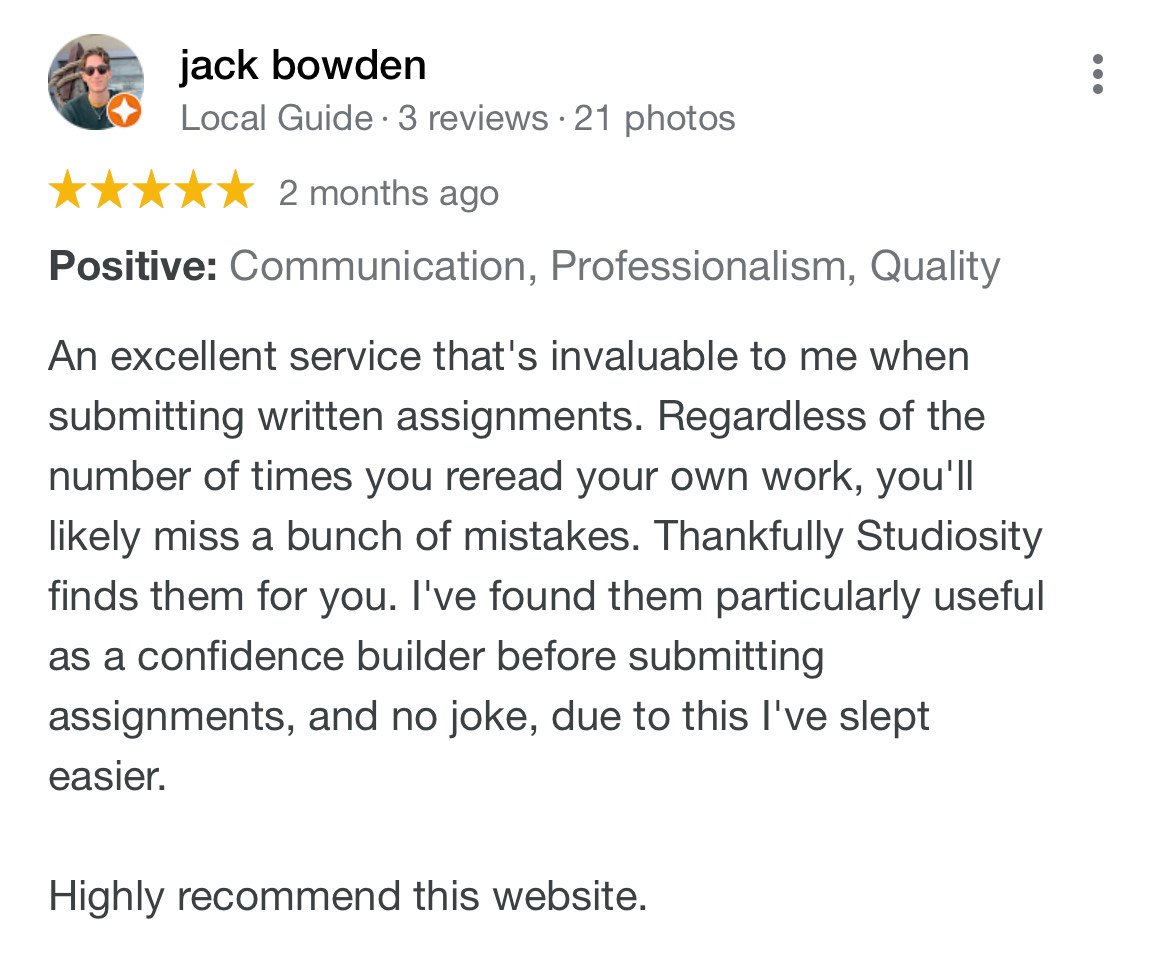
Studiosity acknowledges the Traditional Indigenous Custodians of country throughout Australia, and all lands where we work, and recognises their continuing connection to land, waters, and culture. We pay our respects to Elders past and present.
Contact • FAQ • Privacy • Accessibility • Acceptable Use • Terms of Use AI-for-Learning Polic y • Academic Integrity Policy

IMAGES
VIDEO
COMMENTS
Editing happens before proofreading and includes making content, structural, and organizational changes. Proofreading is the last stage in the writing process and happens before the writing is published or submitted. Proofreaders check for grammar, spelling, punctuation, capitalization, and formatting inconsistencies.
In professional publishing, copy editing is the act of improving what an author writes. Proofreading, on the other hand, is a safety net that ensures that the author and copy editor didn't miss anything. These are two different jobs with the same goal: making a piece of writing as readable and error-free as possible.
The main differences between Copy Editing and Proofreading lie in their depth of review, the scope of their changes, and their timing in the editing process. Regarding their depth of review, copy editing involves a comprehensive review of the content, including its clarity, organization, and factual accuracy. Proofreading, on the other hand, is ...
In publishing, proofreading comes into play at the very end of the editorial process, after a manuscript has been corrected by a copy or line editor. The proofreader's job is to comb through the document and look for any mistakes that may have slipped through the cracks. Regardless of how meticulous the writer and editor have been, there will ...
While editing techniques aim to enhance the readability of your text, proofreading involves surface-level checks such as elimination of grammatical, punctuation, and spelling errors to ensure precision. It is important to understand the difference between editing and proofreading to improve the quality of your writing. Editing: Definition and ...
Try to keep the editing and proofreading processes separate. When you are editing an early draft, you don't want to be bothered with thinking about punctuation, grammar, and spelling. ... A Guide for Book Publishing and Corporate Communications, 3rd ed. Berkeley: University of California Press. Lanham, Richard A. 2006.
Level of detail: Copy editing involves a more in-depth review of the text, while proofreading is a more focused and superficial review of the text. It is important to understand the differences between copy editing and proofreading so that you can choose the right editing process for your writing needs.
The main difference between proofreading and editing is: Editing can involve significant changes to text, structure, and writing style. It focuses on making the text clear and engaging. Proofreading is about correctness and consistency, ensuring that no surface errors remain in the text.
Line editing (i.e., paragraph-level editing) Copy editing (i.e., focusing on technical details and consistency) Proofreading (i.e., correcting any typos in the final draft) The lines between these types of editing are not always clear. But if we look at them in more detail, it should become easier to see what each involves.
A proofreader's job is to clean up the final piece before it's ready to publish. Your proofreaders usually won't make significant changes to your copy or writing style. 2. Purpose. Editing and proofreading are both necessary to make your writing the best it can be, but their purpose is different.
A copy edit is the lowest level of edit. Rarely does a manuscript need "just" a copy edit. Sometimes a copy edit is a final step performed separately by your editor or someone else with fresh eyes. Some editors (like me) do copy editing all along looking for these types of errors, and a copy edit is part of the line edit.
Swift Book Publishing, an Amazon book publishing agency, is here to ace it for you Are mistakes or confusing sentences a problem for you? ... This guide explains the difference between Proofreading vs. Editing to help you write better. Skip to content +1(425) 272-5279. Home; Services. Book Editing; Book Trailer; Book Audio; Book Proofreading ...
Traditionally, proofreading (also known as comparison proofing or blind proofing) comes at the end of the editing process after typesetting. It's the final comb-through of the manuscript or book to ensure it is error-free. Before digital print technology, manuscripts were typeset by hand using moveable type and metal plates.
The table below lists the main differences between proofreading and editing: Proofreading. Editing. 1. Performed on the final draft of the document. Performed on the first draft of the document and continues till the draft is finalized. 2. Addresses surface-level issues. Addresses the core features of writing.
Editing provides an opportunity to make your writing better, whilst proofreading is a final check to ensure perfection before publication. Ideally a writer would receive an editing service first, and subsequently a final proofread just before publication. While we recommended this approach to book authors who covet publishing success, the ...
The four stages of editing and proofreading. Type of editing. What it involves. Step 1: Content editing. Revising an early draft of a text, often making significant changes to the content and moving, adding or deleting entire sections (also known as developmental or substantive editing). Step 2: Line editing.
While copy editing and proofreading can overlap somewhat, they are two distinct steps in the publication process with several key differences. Copy editing is a more comprehensive review of the content that ensures clarity, coherence, accuracy, and overall quality. It involves not only correcting errors but also improving the overall flow and ...
Whether you're writing a book, term paper, or a personal document, proofreading and editing lead to different outcomes for writers. Find out the difference between an editor vs. a proofreader. Editor vs. Proofreader. The work of the editor and proofreader are separate in the traditional publishing industry.
A big difference when you're comparing editor vs. proofreader is that a proofreader has a much narrower set of tasks than an editor. A proofreader's job is entirely focused on the superficial aspects of a piece of writing—namely its spelling, grammar, and punctuation. They bring to the table an expert-level understanding of the structural ...
Copy editing vs proofreading. A copy edit focuses on fixing a wide range of mistakes, ... You are the author. Your name is on the front cover of your book. Your editor is a professional who can guide you in writing the best book you can. We're also not your high school English teacher, so we will actually make editorial changes for you and ...
If proofreading is a science, editing is an art. Editing is the process of improving the overall quality of writing to make an essay the best it can possibly be. It uses much more creativity and often considers the feelings of the work's audience. As such, editing can cause extensive changes to text, bringing up questions such as:
Scope. The difference between proofreading and copy editing also lies in their scope. Proofreading is typically the last check before publishing a document, focusing on minor errors and inconsistencies. In contrast, copy editing occurs earlier and involves a more thorough review to enhance the content's effectiveness.